
OC240498
6 June 2024
Irene
[FYI request #26665 email]
Tēnā koe Irene
I refer to your email dated 8 May 2024, requesting the following briefings under the Of icial
Information Act 1982 (the Act):
“-OC230894 Air New Zealand: licence variations
- OC240068 Meeting with New Zealand Airports Association
- OC240069 Meeting with Mark Troughear, CEO of Freightways
- OC240136 Update on the ICAO audit
- OC240060 Background to Air Services Agreements
- OC240085 North Shore Airport
- OC240128 Air Navigation System Review and the Interim Aviation Council
- OC231136 Aviation New Zealand Parliamentary function – March 2024”
Of the eight briefings requested, six are released with some information withheld, one is
refused and one is withheld.
Certain information is withheld or refused under the following sections of the Act:
6(a)
as release would be likely to prejudice the security or defence of New
Zealand or the international relations of the New Zealand Government
9(2)(a)
to protect the privacy of natural persons
9(2)(b)(ii)
to protect information where the making available of the information would
be likely unreasonably to prejudice the commercial position of the person
who supplied or who is the subject of the information
9(2)(f)(iv)
to maintain the constitutional conventions for the time being which protect
the confidentiality of advice tendered by Ministers of the Crown and officials
9(2)(g)(i)
to maintain the effective conduct of public affairs through the free and frank
expression of opinions by or between or to Ministers of the Crown or
members of an organisation or officers and employees of any public service
agency or organisation in the course of their duty
9(2)(h)
to maintain legal professional privilege
18(d)
the information requested is or wil soon be publicly available
transport.govt.nz | hei-arataki.nz
HEAD OFFICE: PO Box 3175, Wellington 6140, New Zealand. PH: +64 4 439 9000
AUCKLAND OFFICE: NZ Government Auckland Policy Office, PO Box 106483, Auckland 1143, New Zealand. PH: +64 4 439 9000

With regard to the information that has been withheld under section 9 of the Act, I am satisfied that
the reasons for withholding the information at this time are not outweighed by public interest
considerations that would make it desirable to make the information available.
You have the right to seek an investigation and review of this response by the Ombudsman, in
accordance with section 28(3) of the Act. The relevant details can be found on the Ombudsman’s
websit
e www.ombudsman.parliament.nz
The Ministry publishes our Of icial Information Act responses and the information contained in our
reply to you may be published on the Ministry website. Before publishing we wil remove any
personal or identifiable information.
Nāku noa, nā
Hilary Penman
Manager, Accountability and Correspondence
Annex 1: Document Schedule
Doc #
Reference
number
Document
Decision on request
1 OC230894 Air New Zealand: Licence Variations
Released with some information withheld
under Sections 9(2)(a) and 9(2)(b)(ii).
2 OC240068 Meeting with New Zealand Airports
Refused under Section 18(d).
Association
The briefing is available on the Ministry’s
website: refer to page 80 of this link:
https://www.transport.govt.nz/assets/Upload
s/AdviceProvidedtoSupportConversationswi
thLobbyingGroups.pdf
3 OC240069 Meeting with Mark Troughear, CEO of
Released with some information withheld
Freightways
under Sections 9(2)(a) and 9(2)(b)(ii).
4 OC240136 Update on the ICAO Audit
Withheld under Section 6(a).
5 OC240060 Background to Air Services Agreements
Released with some information withheld
under Sections 6(a), 9(2)(a), 9(2)(b)(ii) and
9(2)(g)(i).
6 OC240085 North Shore Airport
Released with some information withheld
under Sections 9(2)(a), 9(2)(f)(iv) and
9(2)(h).
7 OC240128 Air Navigation System Review and the Interim Released with some information withheld
Aviation Council
under Section 9(2)(a).
8 OC231136 Aviation New Zealand Parliamentary Function Released with some information withheld
– March 2024
under Section 9(2)(a).
transport.govt.nz | hei-arataki.nz
Page 3 of 3

IN CONFIDENCE
Document 1
5 February 2024
OC230894
Hon Matt Doocey
Action required by:
Associate Minister of Transport
Wednesday, 14 February 2024
AIR NEW ZEALAND: LICENCE VARIATIONS
Purpose
Agree to vary Air New Zealand’s Scheduled International Air Service Licence to permit code
sharing to New Delhi with an airline of a third country; and to remove capacity restrictions
that were incorporated in the licence in response to COVID-19.
ACT 1982
Key points
•
Air New Zealand’s Licence currently permits code sharing to New Delhi only by way
of an arrangement with Air India. The proposed licence variation removes that
s 9(2)(b)(ii)
restriction, thereby permitting Air New Zealand to code share to New Delhi
•
In 2020, Air New Zealand’s Licence was among those varied to incorporate
provisions allowing capacity restrictions to be imposed in response to COVID-19, with
a view to reducing the demand on Managed Isolation Quarantine facilities.
•
INFORMATION
You are the licencing authority for Air New Zealand.
RELEASED UNDER
•
A replacement Licence for Air New Zealand, and a notice of your decision for
publication in the
New Zealand Gazette, are attached for your signature.
Recommendations
We recommend that pursuant to section 87J of the Civil Aviation Act 1990 and a delegation
from the Minister of Transport , you:
1
vary Air New Zealand’s Scheduled International Air Service Licence to remove the
THE OFFICIAL
restriction on code share services to New Delhi, thereby permitting code-sharing
Yes / No
with an airline of a third country
2
vary Air New Zealand’s Scheduled International Air Service Licence to remove
capacity restrictions that were incorporated in response to COVID-19
Yes / No
3
sign the attached replacement Scheduled International Air Service Licence in the
Yes / No
name of Air New Zealand Limited
IN CONFIDENCE
Page
1 of
5
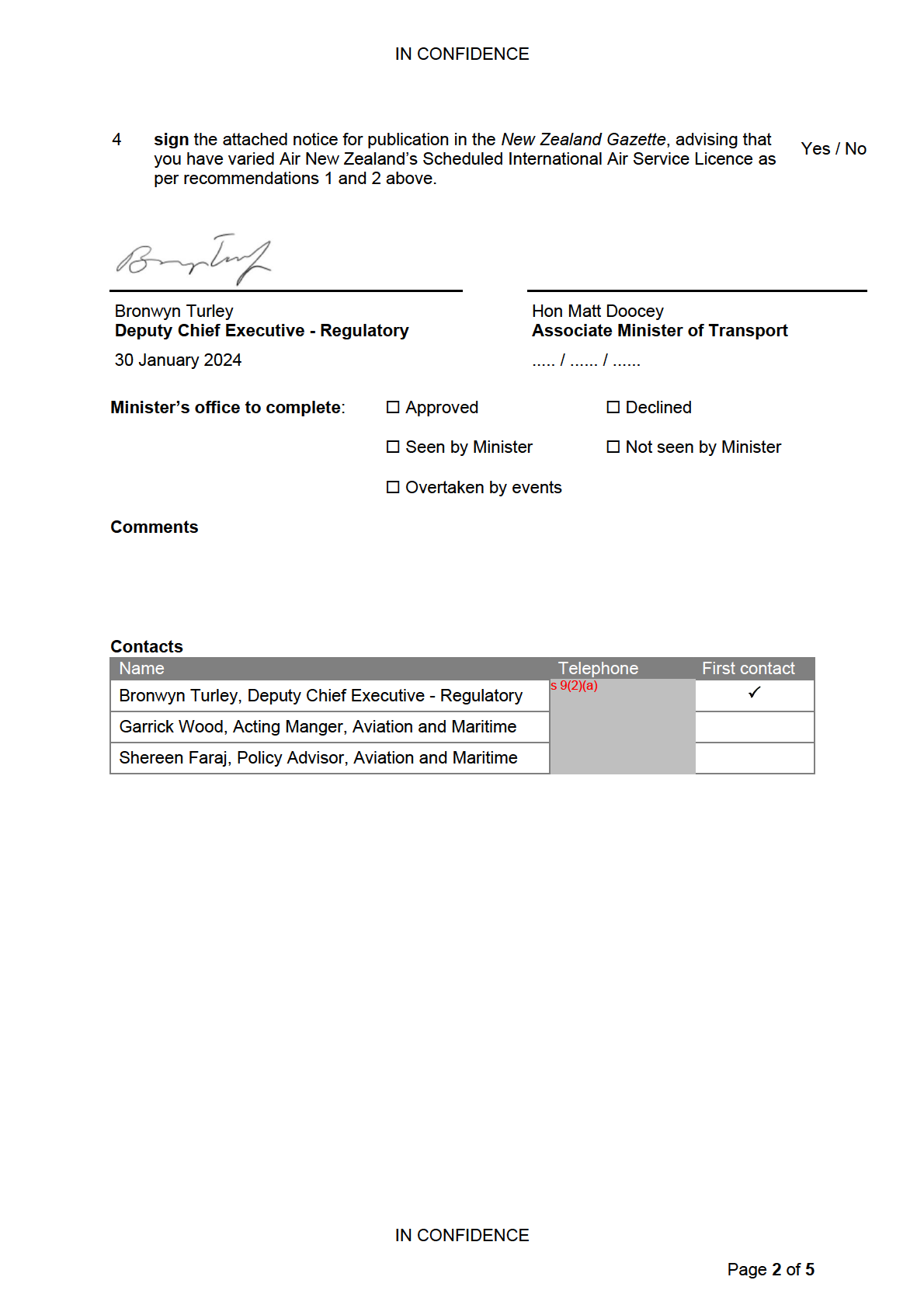
1982
ACT
UNDER
INFORMATION
RELEASED
OFFICIAL
THE

1982
ACT
UNDER
INFORMATION
RELEASED
OFFICIAL
THE
IN CONFIDENCE
Relevant arrangements and agreements
7
The proposed variations to Air New Zealand’s Licence would be consistent with the
relevant bilateral air services agreements and arrangements in force between
New Zealand and the associated countries.
Code sharing to New Delhi
8
New Zealand and India signed a Memorandum of Understanding, on 29 August 2023,
that permits New Zealand airlines to code share to New Delhi with airlines of third
countries. This was as part of wider amendments negotiated with India, including to
the Air Services Agreement, on which we will be reporting to you separately.
Managed Isolation Quarantine (MIQ)
1982
9
As COVID-19 has been declared to be no longer a global health emergency,
Air New Zealand has asked for the removal of the MIQ restrictions inserted in its
Licence in July 2020. All foreign airlines which had the same restrictions imposed,
and for which delegated Ministry officials were the licensing authority, have already
ACT
had them removed.
10
The MIQ provisions allowed for a temporary restriction on passenger numbers. As
MIQ no longer exists, it is appropriate to remove the restriction as its continued
inclusion could be perceived as a capacity constraint. Upon removal,
UNDER
Air New Zealand’s Licence would revert to the version that preceded the MIQ
provisions (except for variations that have occurred since July 2020) and passenger
capacity for own aircraft operations would be as previously stipulated in the licence.
Safety and security requirements
11
Air New Zealand holds a current Air Operator Certificate issued by the Director of
INFORMATION
Civil Aviation. The Certificate meets the safety and security requirements of the
RELEASED
Director and is valid until 26 May 2025.
Financial ability and likelihood of carrying on proposed services
12
Air New Zealand, which is majority owned by the New Zealand Government, is a
long–established international carrier, has appropriate financial resources and is
OFFICIAL
capable of carrying on the services covered by its licence satisfactorily.
Written representations
THE
13
Public notice of Air New Zealand’s application for the licence variations in relation to
code sharing to New Delhi and the removal of the COVID-19 capacity restrictions was
published in the
New Zealand Gazette on 2 October 2023. The period for the receipt
of representations expired on 26 October 2023. No representations were received.
Other matters
14
There are no other matters, as determined by you, that need be taken into account.
IN CONFIDENCE
Page
4 of
5
IN CONFIDENCE
Notice in the New Zealand Gazette
15
Section 87J(6) of the Act requires that, where you have agreed to vary
Air New Zealand’s Licence, notice of this should be published in the
New Zealand
Gazette. A notice is attached for your signature if you agree.
16
The Minister of Transport has delegated to you the authority to vary Air New Zealand
Licence.
1982
ACT
UNDER
INFORMATION
RELEASED
OFFICIAL
THE
IN CONFIDENCE
Page
5 of
5
NOTICE OF VARIATION OF A SCHEDULED INTERNATIONAL AIR SERVICE LICENCE
Further to a notice in the
New Zealand Gazette of 26 October 2023, and pursuant to section 87J(6)
of the Civil Aviation Act 1990, I, Matt Doocey, Associate Minister of Transport, acting under a
delegation from the Minister of Transport, give notice that, having received an application from Air
New Zealand Limited, have varied the Scheduled International Air Service Licence held by that
airline to:
•
remove the restriction on code share services to New Delhi, thus permitting code-sharing
with an airline of a third country
•
1982
remove capacity restrictions that were incorporated into the airline’s licence in response to
COVID-19.
The variations took effect from the date of signature below.
ACT
Signed at
this
day of
2024.
UNDER
Hon. Matt Doocey
Associate Minister of Transport
INFORMATION
RELEASED
OFFICIAL
THE
I, MATT DOOCEY, Associate Minister of Transport, pursuant to section 87J of the Civil Aviation
Act 1990, acting under a delegation from the Minister of Transport VARY and REPLACE the
Scheduled International Air Service Licence first granted on 19 August 1997 to
Air New Zealand
Limited (“the licensee”) of Auckland, New Zealand, a designated airline of the Government of
New Zealand, for the carriage of passengers, cargo and mail. Such carriage is to be in accordance
with the conditions specified in this Licence.
1
Replacement Licence
This is a varied licence and replaces the licence issued to the licensee with effect from 11
February 2022.
2
Routes and Capacity
The licensee may carry on scheduled international air services in both directions over the
1982
routes listed in the attached Annex and with the capacity stated therein.
3
Nature of Service Filings
a
The licensee shall file with the Secretary for Transport.:
ACT
i
a statement of the nature of the services proposed to be operated for each IATA
schedule period; and
ii
any proposed amendment to that statement,
UNDER
not less than 30 days ahead of their effective date, or at such shorter notice as
the Secretary may allow.
b
Nature of service filings shall include, in respect of each service to be operated:
i
the period of operation, with dates;
ii
the points to be served and the route to be followed;
iii
the aircraft type to be used, and, for passenger services, the seating
INFORMATION
configuration;
RELEASED
iv
the capacity to be purchased on any code-shared services using the aircraft of
another airline, and the name of that airline;
v
the frequency of the service per week; and
vi
the flight numbers of the service.
c
The Secretary for Transport shall either acknowledge such filling in respect of each air
OFFICIAL
service or refer such a filling to the Minister of Transport for consideration.
d
The Minister of Transport may either disallow a nature of services filling so referred or
direct the Secretary for Transport to acknowledge such a filling.
THE
e
The Minister of Transport shall advice the licensee of the reasons for disallowing such
a filling and may invite the licensee to lodge an amended filing with the Secretary for
Transport.
f
No new or amended nature of services filing shall take effect unless and until it is
acknowledged by the Secretary for Transport.
g
The Minister of Transport may at any time disallow, in whole or in part, an existing
nature of services filing referred to the Minister by the Secretary for Transport.
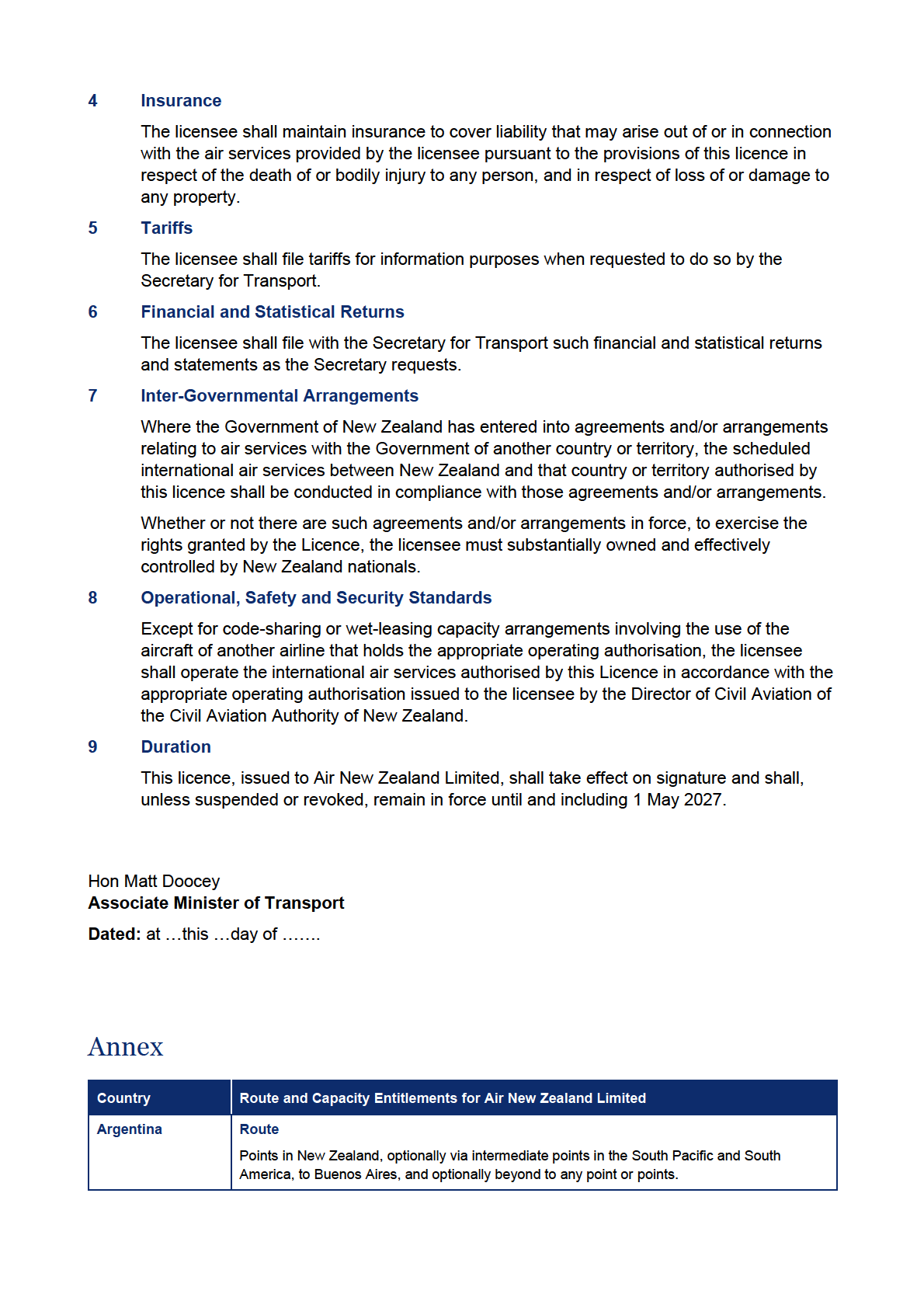
1982
ACT
UNDER
INFORMATION
RELEASED
OFFICIAL
THE

1982
ACT
UNDER
INFORMATION
RELEASED
OFFICIAL
THE
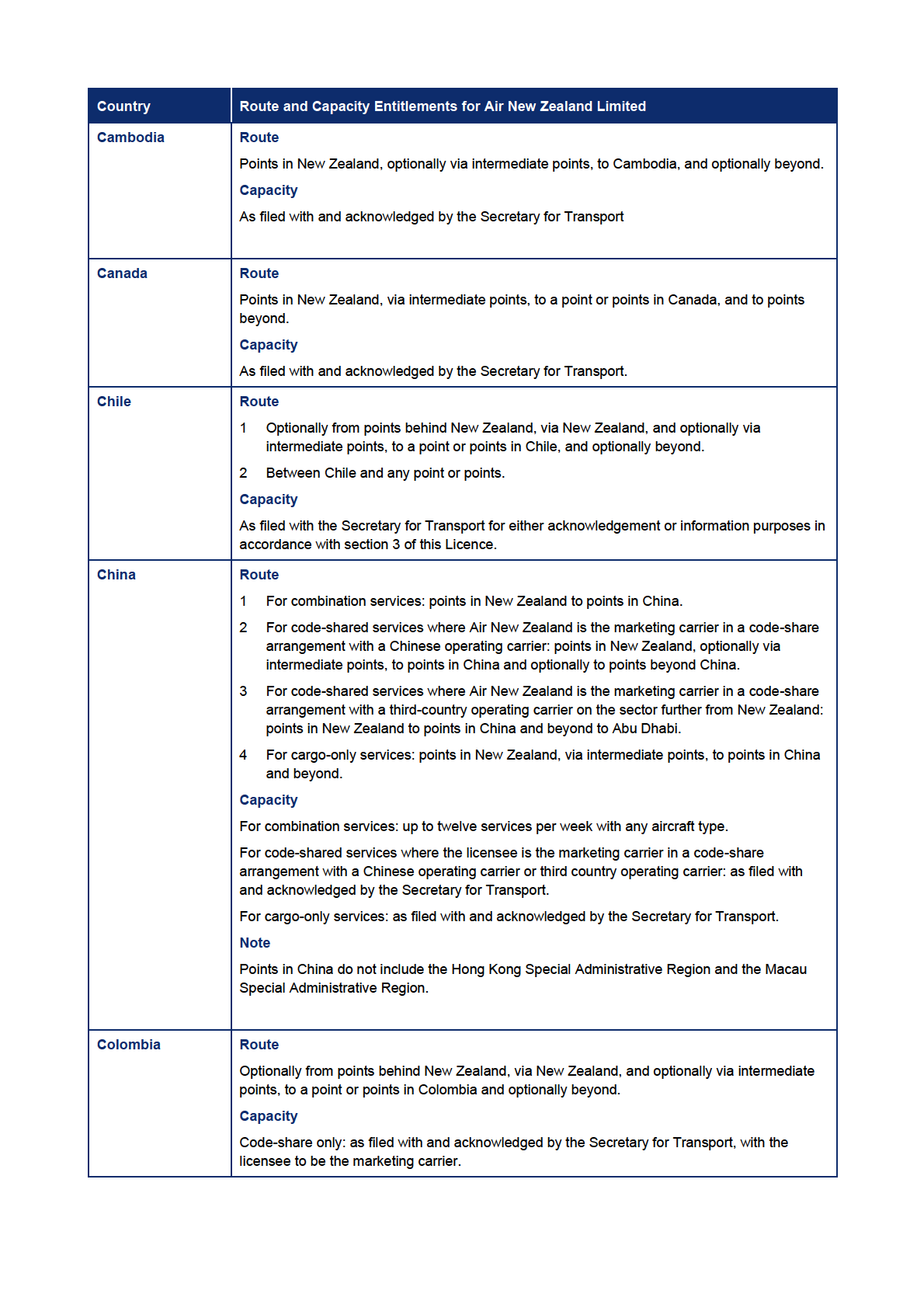
1982
ACT
UNDER
INFORMATION
RELEASED
OFFICIAL
THE
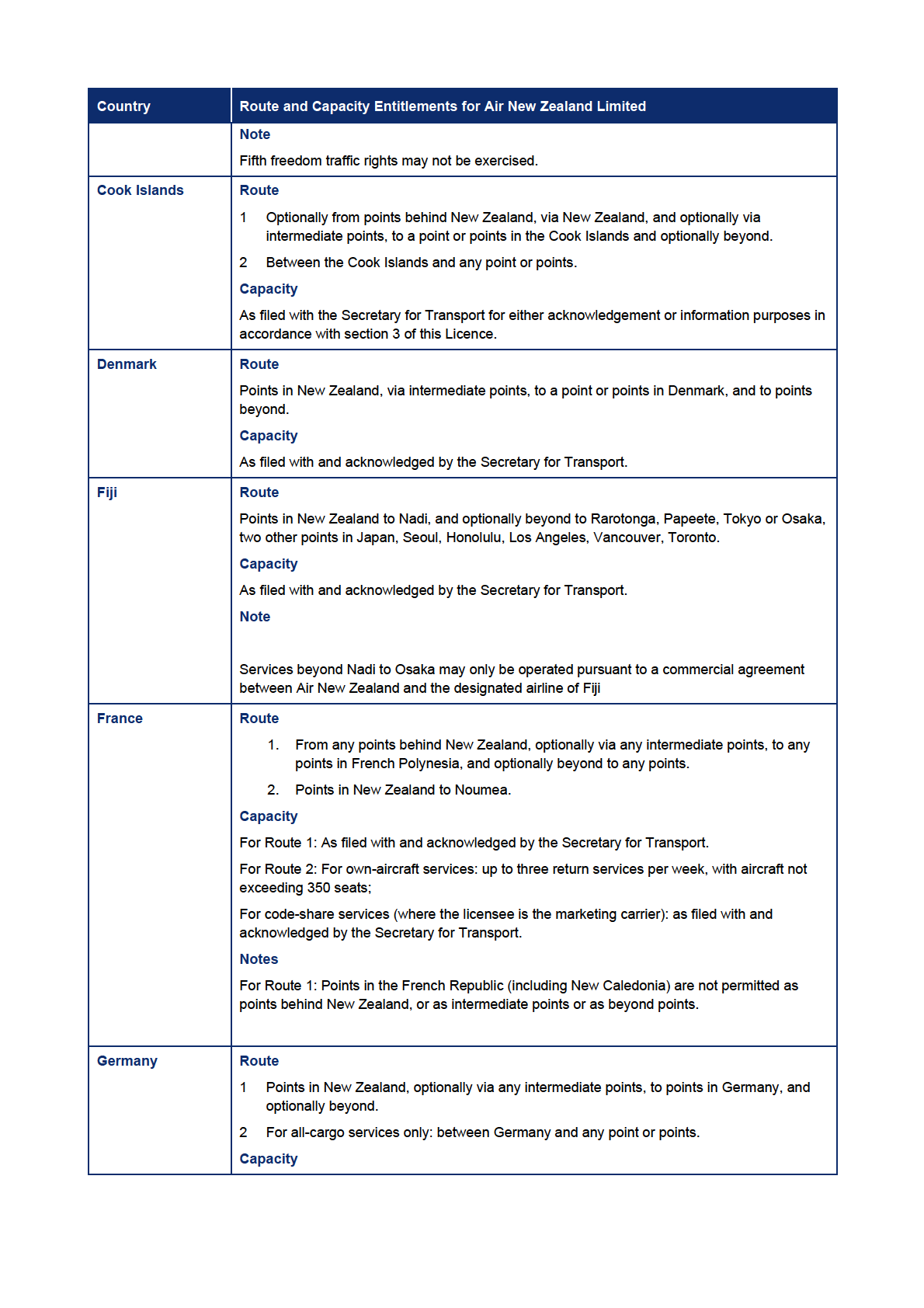
1982
ACT
UNDER
INFORMATION
RELEASED
OFFICIAL
THE
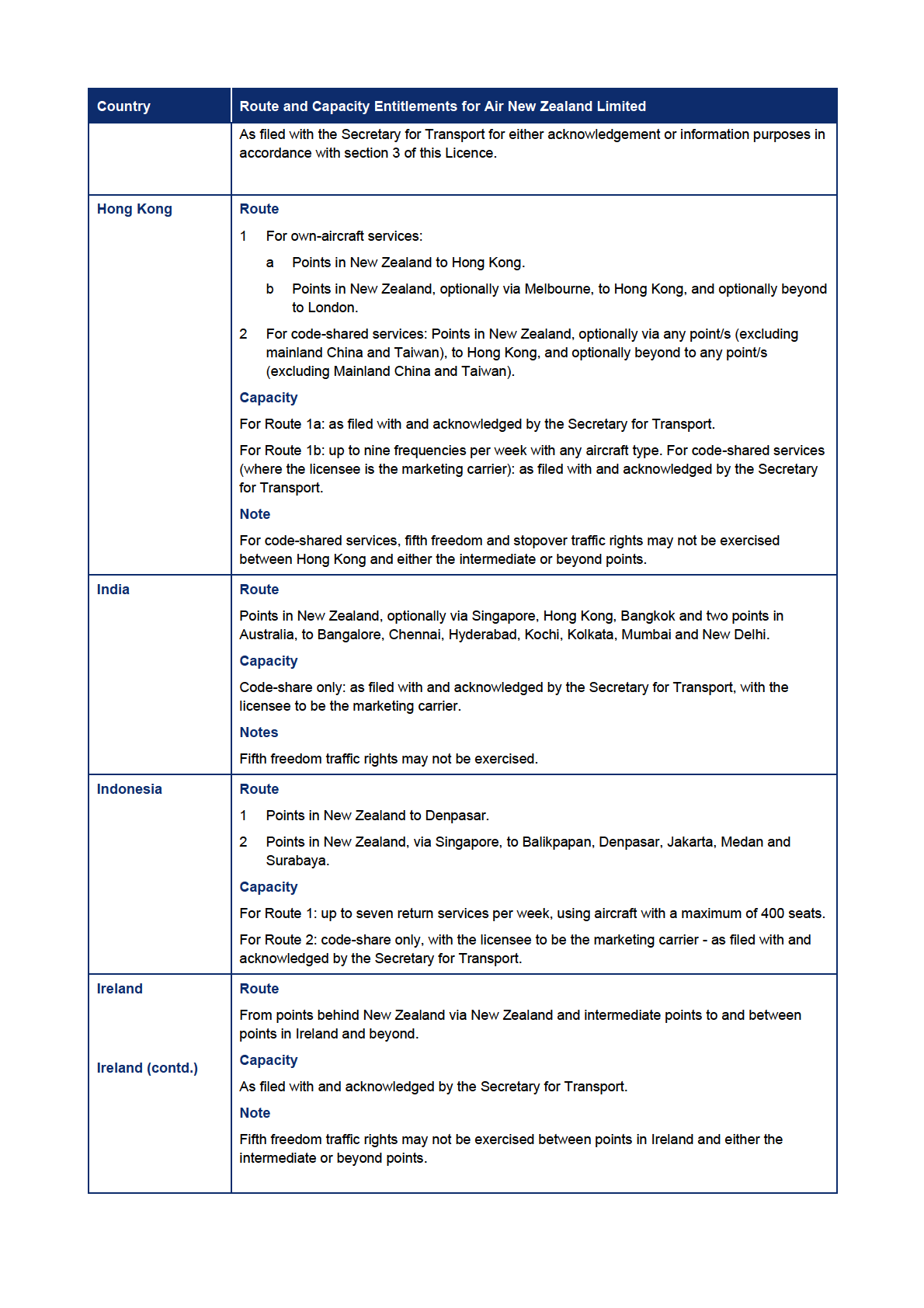
1982
ACT
UNDER
INFORMATION
RELEASED
OFFICIAL
THE
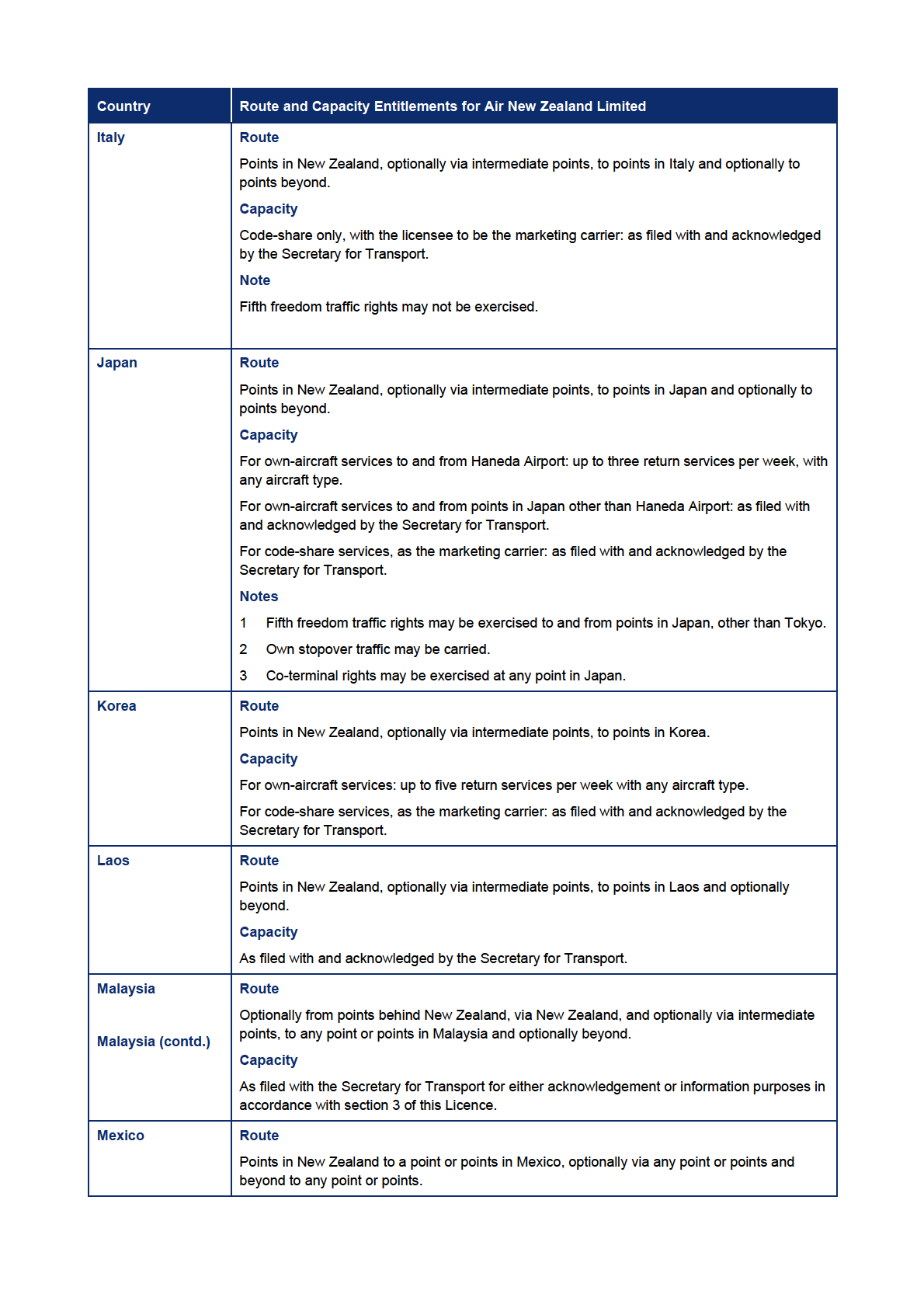
1982
ACT
UNDER
INFORMATION
RELEASED
OFFICIAL
THE
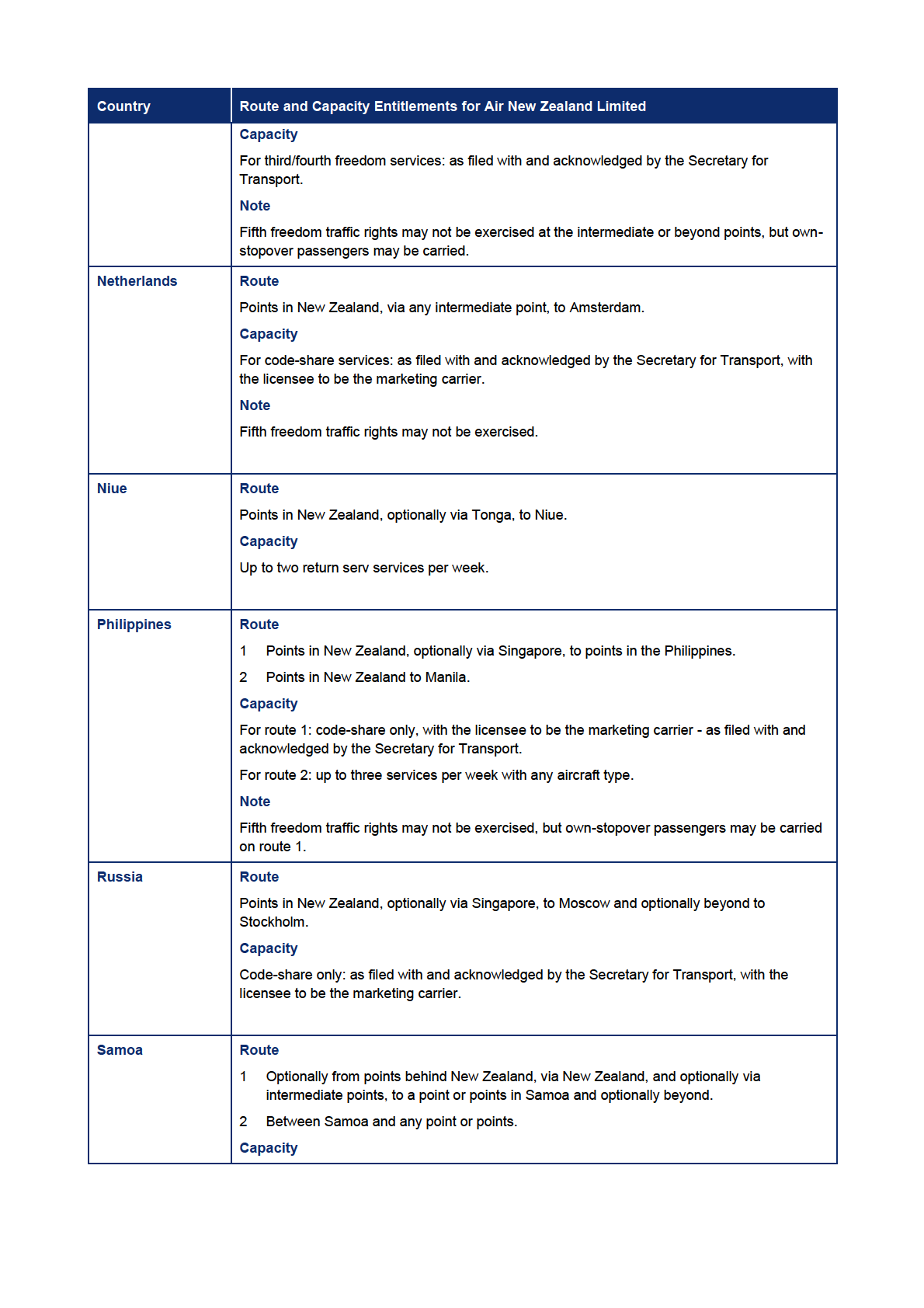
1982
ACT
UNDER
INFORMATION
RELEASED
OFFICIAL
THE

1982
ACT
UNDER
INFORMATION
RELEASED
OFFICIAL
THE
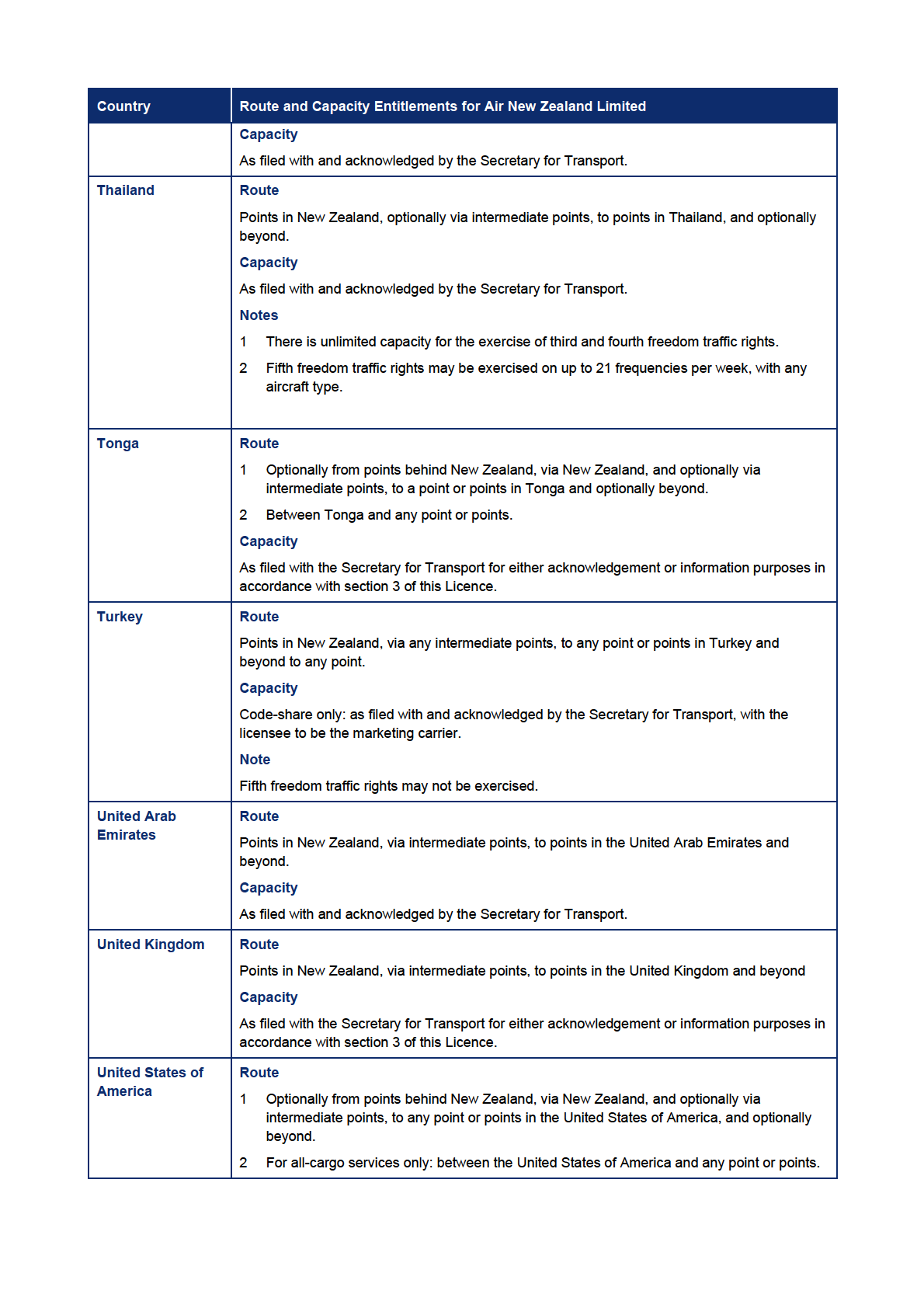
1982
ACT
UNDER
INFORMATION
RELEASED
OFFICIAL
THE
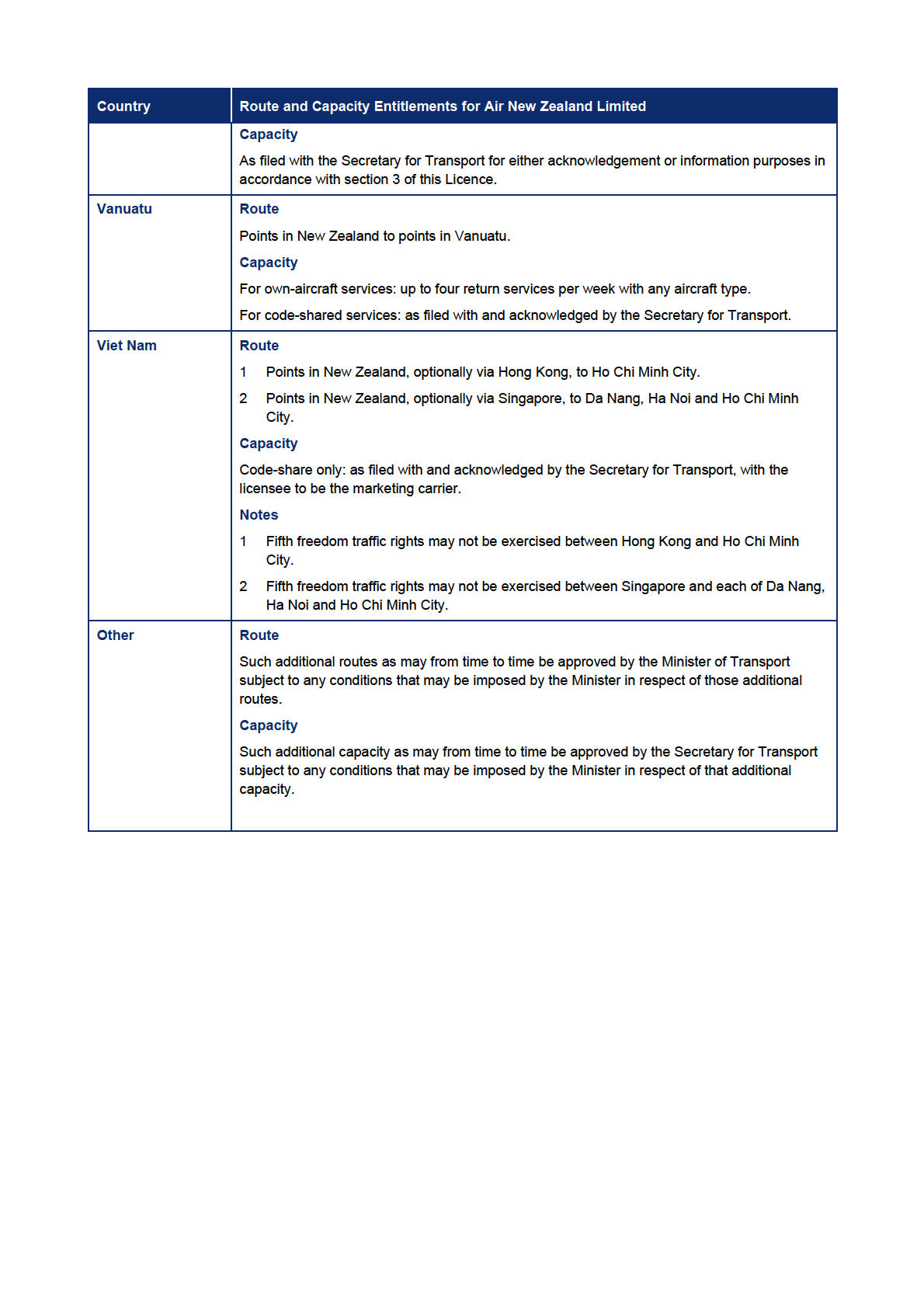
1982
ACT
UNDER
INFORMATION
RELEASED
OFFICIAL
THE
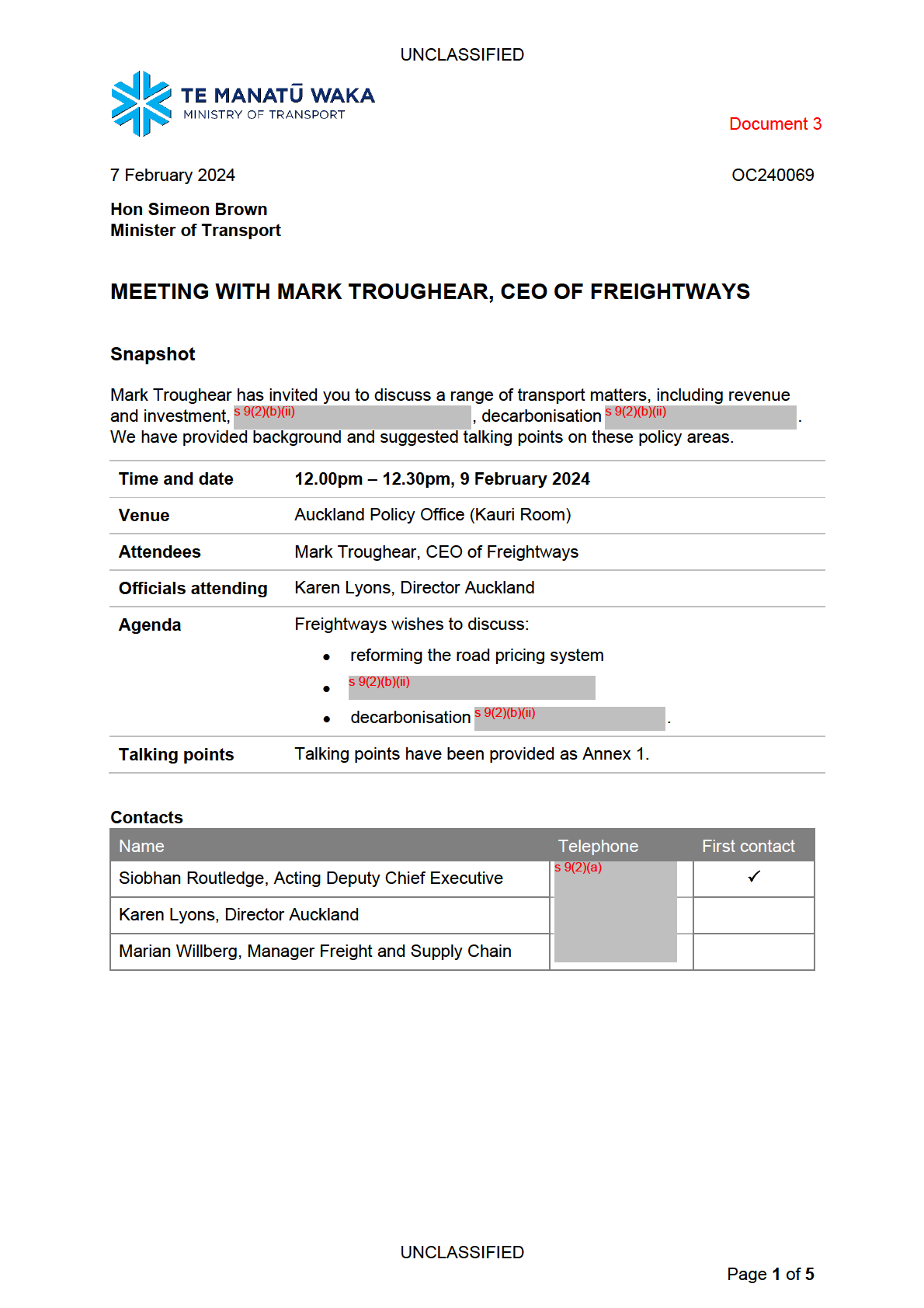
1982
ACT
UNDER
INFORMATION
RELEASED
OFFICIAL
THE
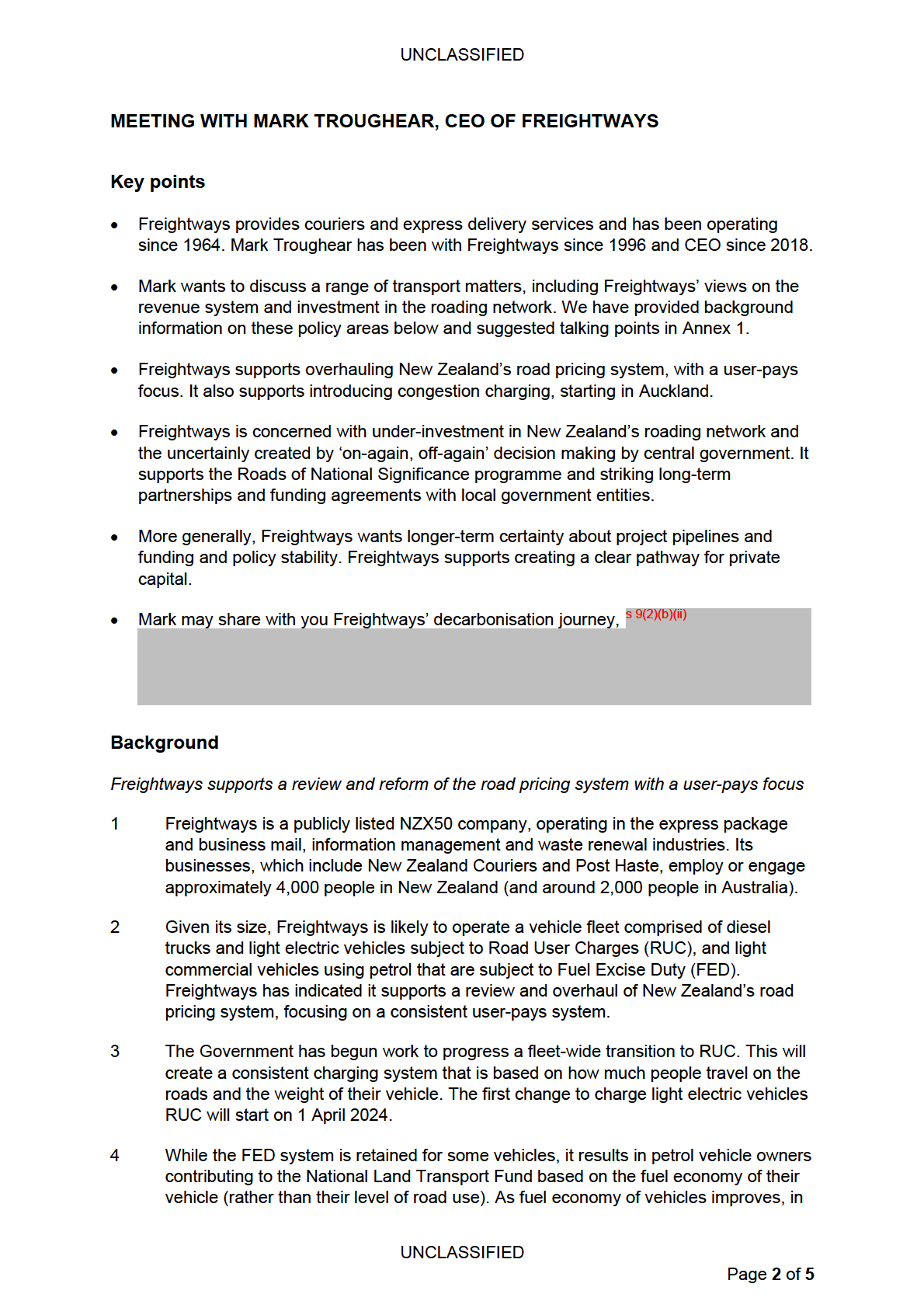
1982
ACT
UNDER
INFORMATION
RELEASED
OFFICIAL
THE
UNCLASSIFIED
particular for hybrid vehicles, this creates a potential revenue risk. It particularly
disadvantages people with older and less fuel-efficient vehicles.
5
The transition to RUC is initially focused on bringing all light vehicles into the system.
There may be opportunities to consider the cost allocation methodology and the
amount paid by heavy vehicles, the use of technology and electronic distance
charging. In particular, there were some improvements and changes to the RUC
system that were proposed in 2021 through the Ministry’s consultation on
Driving
Change: Reviewing the Road User Charges System. There wil be opportunities
through the shift of all vehicles into the RUC system to provide you with further advice
on and implement some of these proposals. You may like to ask Mark what changes
Freightways would seek in relation to RUC for heavy vehicles.
Freightways supports introducing congestion charging – first and foremost in Auckland
6
Freightways supports introducing “time of use” or congestion charging in New 1982
Zealand. It is keen to provide input to officials as work in this area progresses.
Overseas examples of time of use pricing suggest that freight companies are one of
the main beneficiaries. Such companies can pass the costs on but benefit from
ACT
reduced light passenger vehicle traffic.
7
Of icials are working on advice to progress time of use pricing under this Government.
There wil be opportunities for Freightways to engage as this work and legislative
change progresses. Officials wil work with Auckland Council and Auckland Transport
UNDER
to ensure the best scheme is designed for Auckland, as well as in other cities.
Freightways wants more investment in New Zealand’s roading network
8
Freightways supports bringing back the Roads of National Significance programme
and striking long-term partnerships and funding agreements with local government
entities. Additionally, Freightways believes creating a clear pathway for private capital
would be beneficial to New Zealand’s economic and social success
INFORMATION .
RELEASED
9
You may wish to mention that you plan to release the draft Government Policy
Statement on land transport for public consultation shortly, and that it will prioritise
new Roads of National Significance, road maintenance and pothole repair and
encourage the use of alternative funding models for transport infrastructure delivery.
s 9(2)(b)(ii)
OFFICIAL
s 9(2)(b)(ii)
10
THE
11
12
UNCLASSIFIED
Page
3 of
5
UNCLASSIFIED
13
s 9(2)(b)(ii)
14
Freightways is working to decarbonise its company operations and vehicle fleet
15
Mark may raise Freightways’ efforts to reduce its emissions. It was named a Top 10
Carbon Reducer by Toitū Envirocare in 2020, reducing its emissions by more than
5,000 tonnes in that year. Freightways is currently assessing if there are suitable
1982
electric replacements for its courier vans and heavy vehicles.
16
The Government’s approach to reducing emissions from the freight sector wil be
ACT
developed through the second emissions reduction plan, due at the end of 2024. You
may wish to ask Mark what the main challenges are for Freightways to reduce the
emissions across its freight operations, including access to suitable electric trucks.
17
Mark may raise the Road User Charge exemption for heavy electric vehicles. It was
UNDER
introduced to support the uptake of zero emissions heavy vehicles by lowering their
operating costs and is set to expire on 31 December 2025. There are some revenue
impacts from the exemption, although vehicle numbers are low. Some in industry
have asked for it to be extended to 2030, to provide certainty. The Ministry can
provide you with further advice and options analysis on request.
s 9(2)(b)(ii)
INFORMATION
18
s 9(2)(b)(ii)
RELEASED
19
OFFICIAL
20
THE
UNCLASSIFIED
Page
4 of
5

UNCLASSIFIED
Biography
Mark Troughear
Mark has been the Freightways CEO since 2018, having held a range of roles
with the company since 1996. These included General Manager of Post
Haste in 2003 and General Manager for Freightways in 2009.
1982
ACT
UNDER
INFORMATION
RELEASED
OFFICIAL
THE
UNCLASSIFIED
Page
5 of
5
UNCLASSIFIED
Annex 1: Talking Points
MEETING WITH MARK TROUGHEAR, CEO OF FREIGHTWAYS
Reforming the revenue system and adding new tools
• The Government has begun work to bring all vehicles into the road user charges system.
This will create a more consistent charging system based on how much people travel and
their vehicle’s weight.
• Our initial focus has been on bringing light electric vehicles into the RUC system, which
will start from 1 April 2024. There may be opportunities to look at the RUC settings for
heavy vehicles too.
1982
•
Question: What would Freightways seek in relation to heavy vehicle RUC?
• The Government supports introducing time of use charging in New Zealand, but this will
require a law change. We want to create a framework that ensures the more efficient use
ACT
of the land transport network. Any law change will include public consultation.
• We wil also consider wider use of tolling and value capture rating to fund infrastructure.
Investing in roading infrastructure and options to make the system more future focused
UNDER
• I am writing a new Government Policy Statement on Land Transport, and plan on
releasing it for public consultation shortly. It wil prioritise new Roads of National
Significance, and road maintenance.
• I intend to move towards a 10 year pipeline of work for the National Land Transport
Programme. The Government is interested in ensuring that we provide a strong
environment to encourage the use of public private partnerships for inf
INFORMATION rastructure
delivery.
RELEASED
s 9(2)(b)(ii)
OFFICIAL
THE
UNCLASSIFIED
Page
1 of
3
UNCLASSIFIED
Reducing emissions s 9(2)(b)(ii)
• The government’s approach to reducing transport emissions is being developed through
the second Emissions Reduction Plan.
•
Question: What are Freightways’ main challenges to decarbonising freight?
s 9(2)(b)(ii)
1982
ACT
UNDER
INFORMATION
RELEASED
OFFICIAL
THE
UNCLASSIFIED
Page
2 of
3
UNCLASSIFIED
s 9(2)(b)(ii)
1982
ACT
UNDER
INFORMATION
RELEASED
OFFICIAL
THE
UNCLASSIFIED
Page
3 of
3


IN CONFIDENCE
Document 5
16 February 2024
OC240060
Hon Matt Doocey
Associate Minister of Transport cc Hon Simeon Brown
Minister of Transport
BACKGROUND TO AIR SERVICES AGREEMENTS AND
NEGOTIATIONS
1982
Purpose
ACT
Provide information to assist you in your role as Minister with responsibility for air services
agreements (ASAs) and negotiations - a responsibility that has close connections to your
Tourism and Hospitality portfolio.
UNDER
Key points
•
International air services are vital to New Zealand’s global connectivity.
•
The Ministry of Transport is the lead agency for the negotiation of ASAs.
•
We have followed a successful policy of negotiating open skies ASAs. These give
airlines the flexibility to respond rapidly to changing market conditions and to take up
INFORMATION
new opportunities. We have open skies ASAs with most of our major tourism markets,
RELEASED
and with the governments of hub airlines that provide connections around the world.
•
There are, however, some ASAs we have with a few trading partners that are less
than optimal. The issues with these agreements are long-standing and have no easy
resolution. We continue to work with the Ministry of Foreign Af airs to find solutions.
OFFICIAL
Recommendation
We recommend you
note the contents of this briefing on New Zealand’s air services
agreements and nego
THE tiations.
Bronwyn Turley
Hon Matt Doocey
Deputy Chief Executive – Regulatory
Associate Minister of Transport
..16... / ..02.... / .2024.....
..... / ...... / ......
IN CONFIDENCE
Page
1 of
8
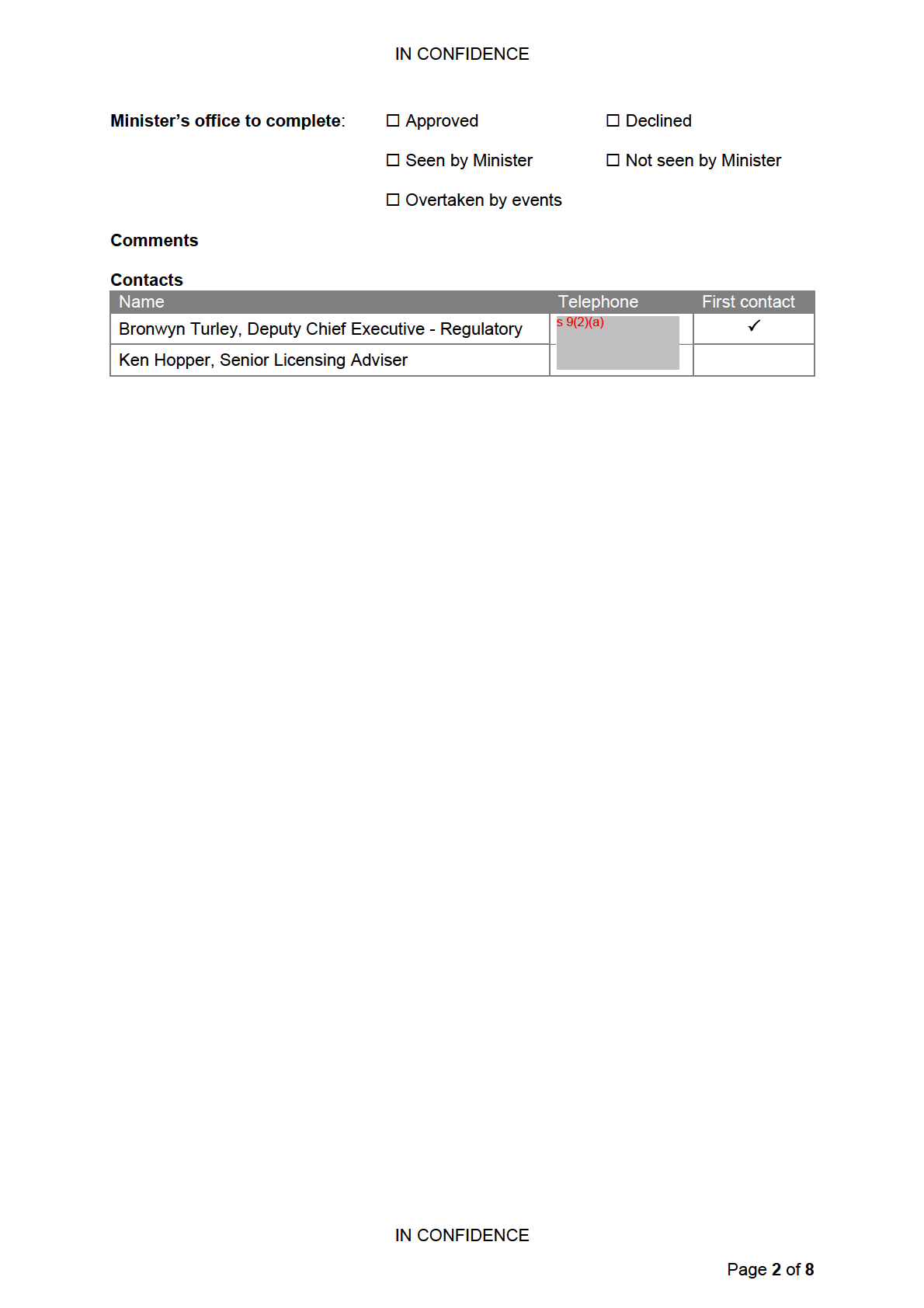
1982
ACT
UNDER
INFORMATION
RELEASED
OFFICIAL
THE
IN CONFIDENCE
BACKGROUND TO AIR SERVICES AGREEMENTS AND
NEGOTIATIONS
Background
1. Under an international system dating back to the 1940s, airlines are able to operate
international services only where the right to do so has been expressly permit ed in a
bilateral air services agreement (ASA) or one of a number of multilateral agreements. An
ASA is required for both passenger and cargo-only scheduled services.
2. Among other things, ASAs set out the routes airlines may operate and the amount of
capacity they are entitled to provide. Aviation safety and security articles are standard,
as are provisions relating to “doing business” matters such as the establishment of local
offices, employment of staff and the repatriation of earnings.
3. New Zealand’s long-standing International Air Transport Policy promotes the negotiation
1982
of ASAs that wil increase New Zealand’s global connectivity.
4. One aspect of the Policy is that officials are required to take into account the particular
needs of Pacific Island countries. The small size of their markets, and the high cos
ACT ts
associated with operating an airline, present Pacific Island countries with significant
challenges in attracting and maintaining air service links. Samoa is a particular example.
It previously had an international airline capable of operating to New Zealand and
Australia, but is now dependent on the airlines of other countries, especially Air
UNDER
New Zealand.
Drivers for negotiating ASAs
5. Due to the success we have had in negotiating open skies agreements that provide
adequate levels of airline access with New Zealand’s principal tourism markets, the
impetus for future air services negotiations wil largely be:
INFORMATION
•
responding to a request for negotiations
RELEASED from an existing air services partner (as
occurred in 2023 with Solomon Islands (on which we are preparing a separate
briefing for you and the Minister of Foreign Affairs), or a prospective new partner
•
responding to a request from a New Zealand airline seeking an air services
opportunity that does not currently exist
OFFICIAL
•
proactively seeking to address unresolved issues with air services partners, e.g.,
France (discussed at paragraph 28 below).
THE
Code-sharing
6. Code-sharing is a marketing tool that enables an airline to sell tickets under its flight
designator, e.g., NZ for Air New Zealand and QF for Qantas, on flights operated by
another airline. Code-sharing benefits airlines by:
IN CONFIDENCE
Page
3 of
8
IN CONFIDENCE
•
Al owing the sale of a through ticket, which appears higher on computer
reservation systems than a ticket sold by sectors. For example, Air New Zealand
can sell a through Auckland – Frankfurt ticket in code-share partnership with
Singapore Airlines, where Air New Zealand operates the Auckland – Singapore
sector and Singapore Airlines the Singapore – Frankfurt sector. A ticket sold
showing different airlines for the two sectors would appear lower in a computer
reservation system and would be less likely to sell.
•
Enabling them to offer services to destinations they cannot viably operate with their
own aircraft. Air New Zealand, for example, places its code on flights to a wide
range of destinations in Asia, Europe and North America that are operated by its
partner airlines.
•
Generating additional traffic to bolster otherwise thin routes. For example, when Air
New Zealand operated to Buenos Aires otherwise empty seats could be fil ed by
1982
passengers coming from flights operated by Aerolineas Argentinas to Brazil and
Colombia on which Air New Zealand sold tickets under a code-share arrangement.
Such code-sharing was possible due to ASAs negotiated by New Zealand with
each of Brazil and Colombia.
ACT
7. Because it is an exercise of traffic rights between countries, an ASA is required before
code-share services can be offered.
UNDER
Air services and tourism
8. The tourism industry’s contribution to the country’s economy would be severely limited
without the international flights made possible by New Zealand’s ASAs.
9. ASAs are in place with all New Zealand’s major tourism source markets. Many of these
are open skies agreements, i.e., there are no restrictions on the number of flights, the
routes to be operated or on the origin/destination of traffic that may be carried.
INFORMATION
RELEASED
10. Significant open skies agreements include those with Australia, Canada, the United
Kingdom and the United States (the latter under the
Multilateral Agreement on the
Liberalization of International Air Transportation, which also includes Brunei, Chile, Cook
Islands, New Zealand, Singapore, Tonga and, on a cargo-only basis, Mongolia).
11. The ASA with China, on the other hand, provides for 70 passenger services per week for
the airlines of each side. There are no restrictions on the number of cargo-only flights.
OFFICIAL
12. A notable feature of New Zealand’s international aviation profile, but not uniquely so, is
that a number of the most significant airlines in terms of numbers carried are not from
tourism source markets. Airlines that are well positioned geographically in the Middle
THE
East and Southeast Asia, but from countries with small domestic markets, use this
advantage to link different parts of the globe. Emirates Airline, Qatar Airways and
Singapore Airlines are in this category. As is Abu Dhabi-based Etihad, which operates to
Australia but code-shares to New Zealand.
IN CONFIDENCE
Page
4 of
8
IN CONFIDENCE
13. This helps explain why no European airlines operate to New Zealand and why Air
New Zealand ceased flying to London (and, earlier, to Frankfurt). For European carriers,
New Zealand represents a long, thin route that would support only a limited number of
services. Economic rationale makes for passengers to be carried by mid-point airlines
that can aggregate passengers. European carriers participate in the New Zealand
market through code-sharing on those mid-point carriers, e.g., Spanish carrier Iberia
code-shares on Qatar Airways’ New Zealand services.
14. Expanding our existing ASAs or entering into new ASAs with emerging markets
(following a commercial decision by airlines to operate direct flights to New Zealand) is
likely to increase the volume of international arrivals, which could grow the export value
of international tourism. However, tourism stakeholders, academics and the media have
indicated social licence concerns about increasing the volume of international visitor
arrivals. There is especial regard to the carbon emissions of international aviation, and
the impact of visitation on local communities and the environment.
1982
15. Any expansion of ASAs and/or increase in direct flight numbers is likely to increase the
volume of tourists visiting New Zealand, and may exacerbate these concerns.
ACT
Looking ahead
16. We will put a priority on new or amended agreements where the current arrangements
are standing in the way of an airline commencing or expanding services. Under the
UNDER
provisions of ASAs, we have a treaty-level obligation to meet with existing bilateral
partners if they request it.
17. s 9(2)(b)(ii)
INFORMATION
18. There are a number of cases (notably Hong Kon
RELEASED g – mainland China, metropolitan
France and Japan,) discussed below, where Air New Zealand is interested in offering
services, but the partner government is not wil ing to engage.
19. Two airlines we are watching are:
•
Thai Airways has not returned to New Zealand after ceasing services at the outset
OFFICIAL
of COVID-19. We do not know the reason for this, but the airline had long been a
significant contributor to New Zealand’s international connectivity. Tourism officials
at the Ministry of Business, Innovation and Employment (MBIE) are seeking further
information about this from the Ministry of Foreign Affairs and Trade (MFAT).
THE
•
Turkish Airlines has been expanding rapidly over the past decade. It has an
extensive international route network, and a well-placed hub at Istanbul’s new
airport. The airline has announced plans to start services to Australia in 2024 and
may consider operating to New Zealand. Turkish Airlines could be expected to
compete, particularly with Emirates and Qatar Airways, in the New Zealand –
Europe market and to grow the size of this.
20. There are no New Zealand-imposed regulatory barriers to services by the two airlines.
IN CONFIDENCE
Page
5 of
8
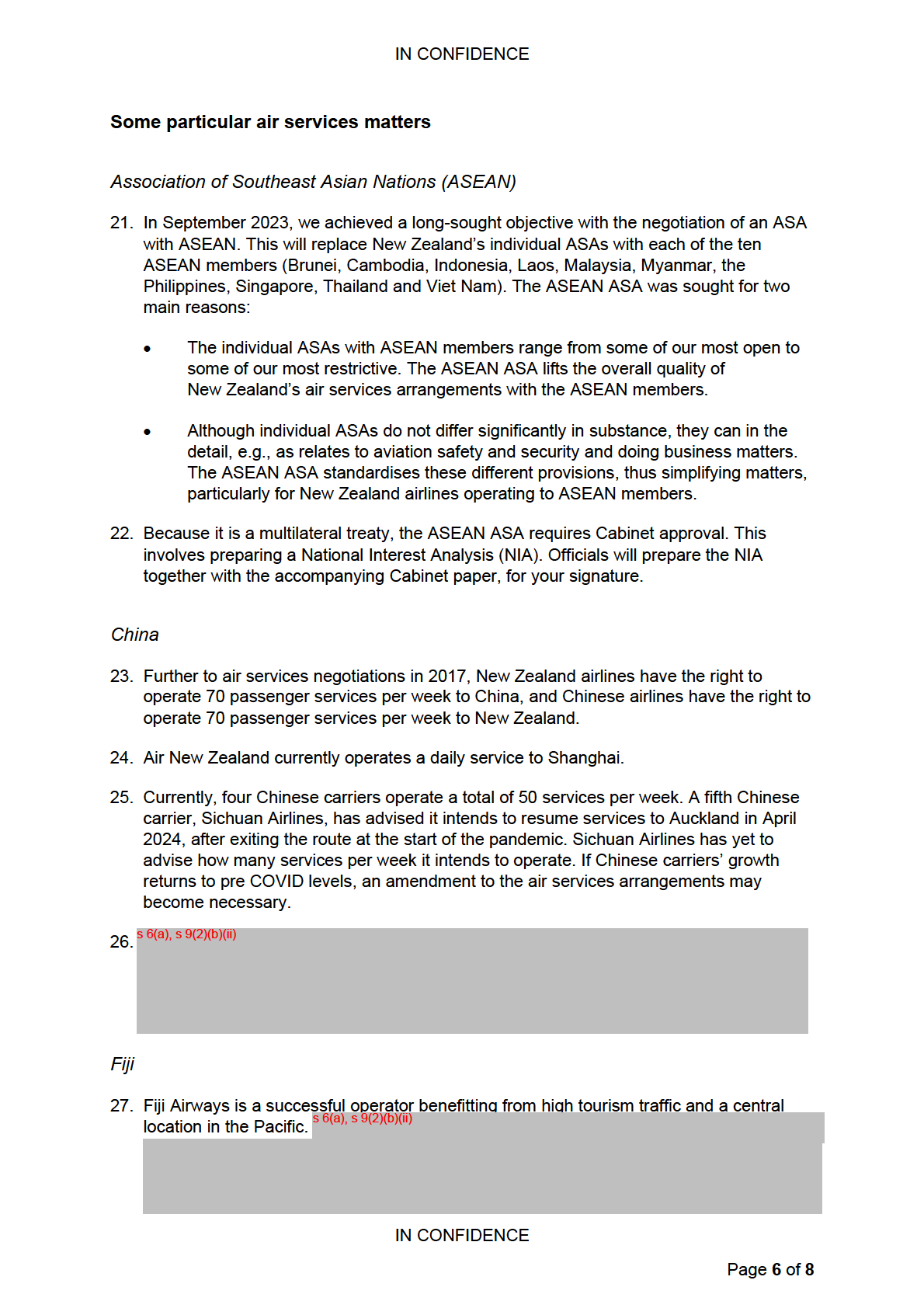
1982
ACT
UNDER
INFORMATION
RELEASED
OFFICIAL
THE

1982
ACT
UNDER
INFORMATION
RELEASED
OFFICIAL
THE

1982
ACT
UNDER
INFORMATION
RELEASED
OFFICIAL
THE

UNCLASSIFIED
Document 6
21 February 2024
OC240085
Hon Simeon Brown
Minister of Transport
NORTH SHORE AIRPORT
Purpose
1982
To provide background on the North Shore Airport’s (the Airport’s) application for airport
authority status under the Airport Authorities Act 1966. You requested a briefing after you
received an invitation from the Airport which refers to this application. You subsequently
declined the Airport’s invitation.
ACT
Key points
UNDER
• On 23 June 2020, North Shore Airport made an application to the Ministry of
Transport for airport authority status under the Airport Authorities Act 1966 (the Act).
• The Airport is a small aero club owned aerodrome that supports several aviation
businesses including air transport and flying schools. It has plans for expansion.
• Airport authority status is not necessary for the development of an airport but
provides powers that can make the process easier.
INFORMATION
•
RELEASED
The Ministry provided advice on the application and the Minister (Hon Michael Wood)
attended a community meeting to help inform his decision. Ultimately the Ministry
recommended airport authority status be granted, but advised it was open to the
Minister to make a different decision.
• The Minister decided not to recommend that the Governor-General grant airport
authority status to the Airport. His reasons included concerns about the Airport being
OFFICIAL
a helpful addition to the network, future infrastructure requirements, and a lack of
sufficient community consultation by the Airport.
•
THE
The Airport wrote to the subsequent Minister (Hon David Parker) requesting a review
of the decision.
• s 9(2)(h)
• s 9(2)(f)(iv)
UNCLASSIFIED
Page
1 of
5
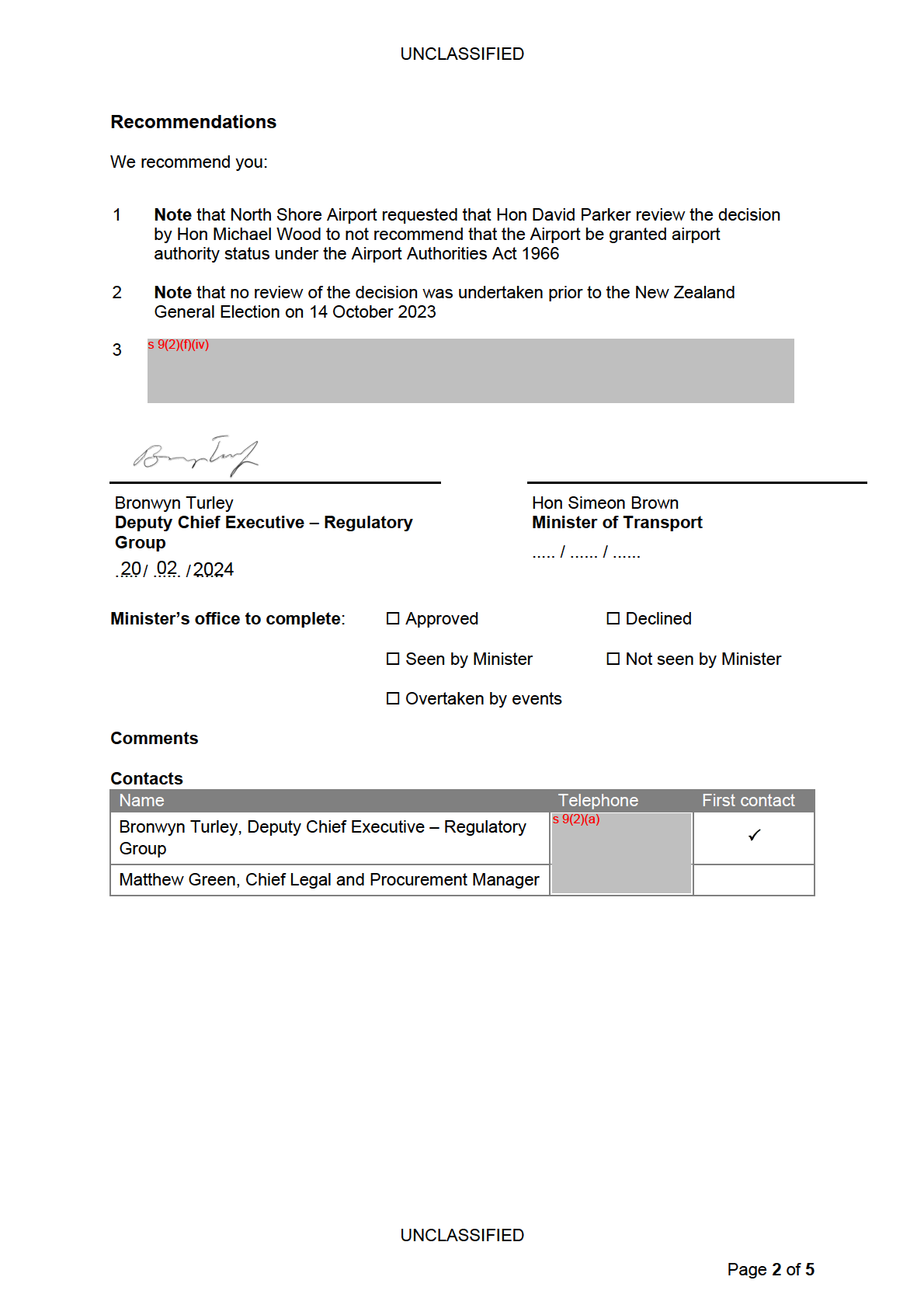
1982
ACT
UNDER
INFORMATION
RELEASED
OFFICIAL
THE
UNCLASSIFIED
NORTH SHORE AIRPORT
North Shore Airport is a small aero club owned airfield
1
North Shore Airport (the Airport) is owned by North Shore Aero Club Incorporated.
2
The Airport is a small regional airport located at 270/284 Postman Road, Dairy Flat,
and has been operated for over 60 years. The Airport is currently used for private
general aviation operations, flight training and light commercial airline services. Its
sealed runway is 791 meters long (which compares to around 2,000 meters at
Wellington Airport).
3
The airport has plans for expansion including scheduled commercial services.
1982
North Shore Airport applied for Airport Authority Status in 2020
4
On 23 June 2020, the Airport applied to the Ministry of Transport for airport authority
status under the Airport Authorities Act 1966 (the Act).
ACT
5
The Airport indicated that its interest in authority status was to help protect its status
as an airport. The Airport viewed airport authority status as a way to keep pace with
the changing operational environment and as an important step for its development.
UNDER
Airport authority status supports, but is not necessary to develop an airport
6
While airport authority status is not needed to develop an airport, the additional
powers it provides may support such plans.
7
Airport authority status provides airports with powers, responsibilities, and obligations
under a range of New Zealand legislation. It allows airports to make bylaws (subject
to approval by the Minister of Transport) and is one step in the process of obtaining
INFORMATION
access to the Public Works Act 1981. There are over 30 airports in New Zealand
RELEASED
operating under airport authority status, ranging from international airports through to
smaller airfields.
8
s 9(2)(h)
OFFICIAL
The previous Minister considered the application through a series of advice
THE
and meetings
The initial application
9
Following community consultation, the Ministry advised Minister (Hon Michael Wood)
that there was no evidence that the Airport would not be able to satisfactorily carry out
the responsibilities of an airport authority (OC210040 refers).
UNCLASSIFIED
Page
3 of
5
UNCLASSIFIED
10
There was a risk of opposition from the community. Concerns raised during
consultation largely centred around aircraft noise and lack of community
engagement.1 However, submissions were roughly divided in half between those
supporting and opposing the proposal.
11
We recommended that the Minister agree that airport authority status should be
conferred on the Airport.
Further advice
12
The Minister asked for further advice from the Ministry.
13
The Ministry advised that modest growth of the Airport would have a neutral to slightly
positive impact in contributing to the transport outcomes strategic framework, the
proposal would not have a negative impact on housing, and local impacts were
1982
appropriately dealt with by local planning processes (OC210685 refers).
14
The advice also noted that: (OC210991 refers)
•
ACT
The potential increase in greenhouse gas emissions from any proposed
expansion of activities at the Airport with the introduction of commercial flights is
expected to be minimal.
•
The locations of the current network of airports in New Zealand was
UNDER
largely driven by developments in aircraft technology, military requirements and
increasing recognition of domestic (and international) air transport, not the result
of strategic design.
15
The Ministry recommended that the Minister agree that airport authority status should
be conferred on the Airport, subject to the condition that it should be required to
comply with the statutory obligations of an airport company (most airport authorities
INFORMATION
are companies whereas North Shore Aero Club is an incorporated society).
RELEASED
16
The Minister subsequently attended a community meeting to help inform his decision
about whether to recommend the granting of airport authority status to the Airport.
The Minister declined the application
17
The Ministry provided the Minister with further advice summarising the factors which
may be considered when assessing an application for airport authority status, largely
OFFICIAL
reiterating the advice detailed above (OC220569 refers).
18
This advice set out the broad discretionary power, as outlined above, and concluded
that while the Ministry’s recommended approach remains to approve the decision, it
THE
would be open to the Minister to not grant the application.
19
The Minister decided not to recommend that the Airport be granted airport authority
status. The Minister indicated concerns about the following:
• Whether the Airport would be a helpful addition to the network,
1 Similar concerns were raised by the West Auckland community during consultation in 2019 when
West Auckland Airport (Parakai) applied for Airport Authority Status. West Auckland Airport was
granted Airport Authority Status in 2020 by the then Minister of Transport, Hon Phil Twyford.
UNCLASSIFIED
Page
4 of
5
UNCLASSIFIED
• What the infrastructure requirements would be if the Airport grew, and
• Whether there has been sufficient consultation with the community about the
Airport’s future plans.
The airport sought a review of the Minister’s decision
20
The Airport wrote to the subsequent Minister (Hon David Parker) requesting a review
of the decision.
s 9(2)(h)
21
1982
s 9(2)(f)(iv)
ACT
22
A decision on the Airport’s request for a review was not made prior to the New
Zealand General Election on 14 October 2023. The decision on whether to
recommend to the Governor-General to grant airport authority status now sits with
you.
UNDER
23
s 9(2)(f)(iv)
24
INFORMATION
25
RELEASED
The Civil Aviation Act 2023 will make changes to the process for the future
26
For your awareness, the Civil Aviation Act 2023 will replace the Act when it comes
OFFICIAL
into force on 5 April 2025. Once this happens, airports can apply to the Secretary of
Transport for registration, rather than to the Minister for authorisation. The Ministry
has previously advised that the Airport could apply again under the new provision.
The Airport would like the issue considered ahead of that timeframe.
THE
27
Under this new provision, the Secretary is explicitly required to consider specified
factors, including whether registration is consistent with the purpose of the Civil
Aviation Act 2023.
UNCLASSIFIED
Page
5 of
5
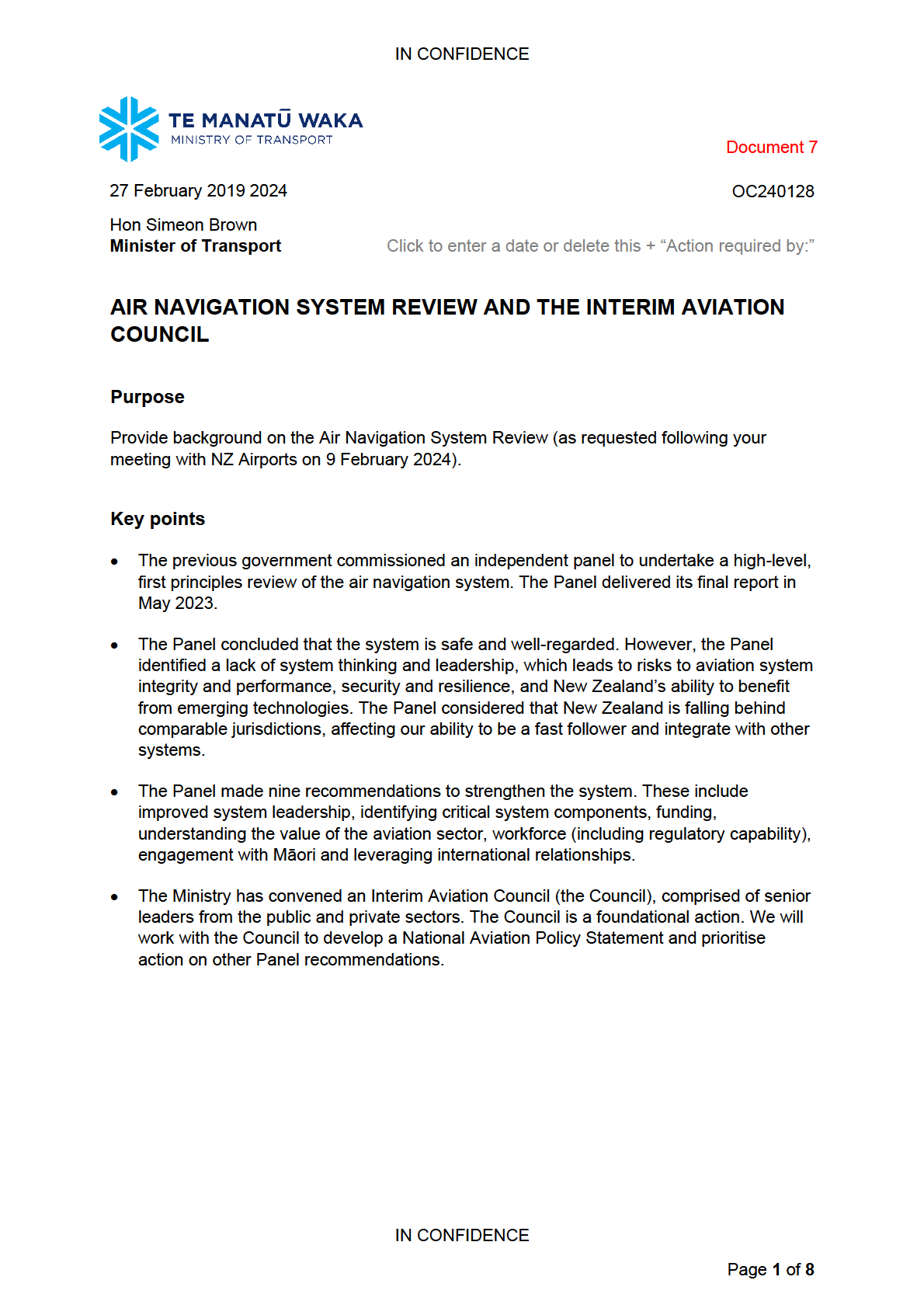
1982
ACT
UNDER
INFORMATION
RELEASED
OFFICIAL
THE
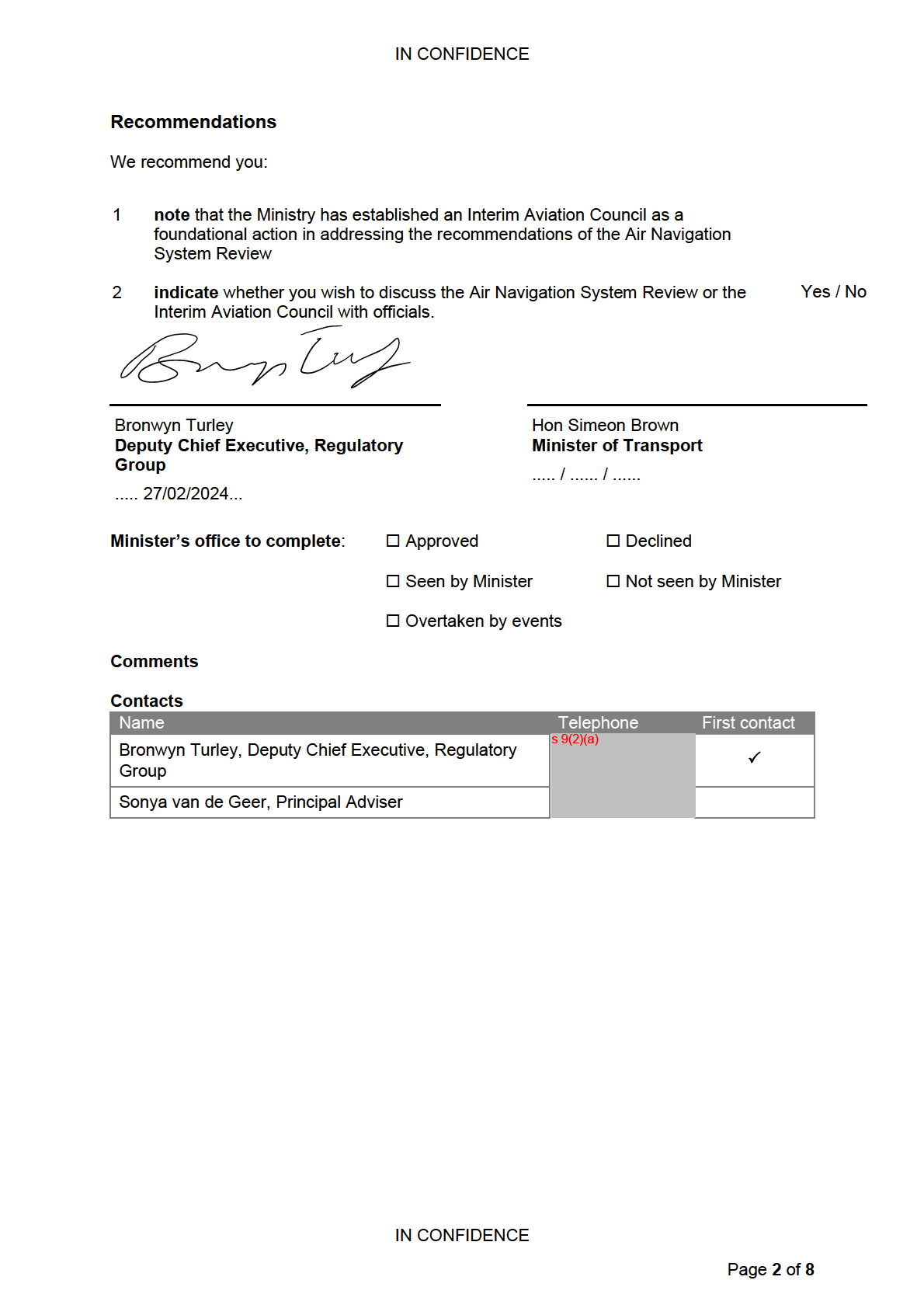
1982
ACT
UNDER
INFORMATION
RELEASED
OFFICIAL
THE
IN CONFIDENCE
AIR NAVIGATION SYSTEM REVIEW AND THE INTERIM AVIATION
COUNCIL
The air navigation system is critical infrastructure
1
The air navigation system is a critical part of New Zealand’s core infrastructure,
enabling the safe operation of aircraft.
2
A modern and responsive air navigation system is essential to keeping New Zealand
safe, connected, growing, resilient and secure. New Zealanders derive significant
value from the system – both directly and indirectly.
3
The system also enables access to essential public services, including healthcare via
air ambulance services in emergencies and routine patient transfers. It is also critical
1982
for civil defence and emergency responses across the nation and the wider South
Pacific region.
4
The aviation system is innovative, productive, and growing. Airspace and aircraft
ACT
innovation is expanding the potential for future business activity, foreign direct
investment, and productivity growth.
An independent panel undertook a review of the air navigation system
UNDER
5
Stakeholders had raised a number of issues regarding the air navigation system,
including:
•
The lack of a high-level statement of the principles and objectives for our air
navigation system
•
Concern that the regulatory settings are not responsive enough to grasp the
INFORMATION
opportunities and manage the risks of new technologies
RELEASED
•
Concerns about cross-subsidisation in the system and funding for air navigation
services with public good components.
6
In response to these issues, the previous government commissioned an independent
panel to undertake a high-level, first principles review of the air navigation system.
The Panel delivered its final report in May 2023.
OFFICIAL
The panel concluded that the system is safe but needs to adapt
7
The Panel concluded that the system is safe and is well regarded. While it is not in
THE
crisis, the system needs change to effectively manage emerging technologies and
new threats, thereby ensuring the system is fit for the future.
Global disruptive forces are placing demands on the system
8
The Panel highlighted that global disruptive forces for change are placing increasing
demands on system agencies and actors to think and behave as a more
interconnected system. Changes include:
•
Airspace modernisation and integration of new and emerging technologies
IN CONFIDENCE
Page
3 of
8
IN CONFIDENCE
•
Advanced cyber technology and security capability requirements
•
Decarbonisation of aviation and adapting to the impacts of climate change
•
Dynamic tensions and shifts in the geopolitical environment
•
Increasing global and regional interoperability.
More system-level thinking is required
9
The Panel contended that the system’s role as a critical national infrastructure is
undervalued. They found that its broader role in delivering a range of economic,
social, environmental, and cultural benefits is not well understood.
10
The Panel identified a lack of system thinking and leadership, which poses risks to
system integrity and performance, security and resilience, and our ability to benefit
from emerging technologies. The Panel considered that New Zealand is falling behind
comparable jurisdictions, which will affect our ability to be a fast follower and integrate
1982
with other systems.
The Panel made nine system-level recommendations
ACT
11
The Panel made nine recommendations (attached as Annex 1). These include
improved system leadership, identifying critical system components, funding,
understanding the value of the aviation sector, workforce (including regulatory
capability), engagement with Māori and leveraging international relationships.
UNDER
12
The Panel’s Terms of Reference required it to take a system-level view. Accordingly,
its recommendations were designed to strengthen system settings, enable decisions
based on robust information, and place a strong focus on effective implementation
with the necessary resources, skills, and relationships at hand. The Panel did not
make detailed recommendations about the levels of future investment required, how a
user pays plus funding model might be applied, or agency form.
INFORMATION
13
We agree with the higher system-level view taken by the independent panel.
RELEASED
Consideration of the Panel’s recommendations provides a valuable framework to
address the wider issues facing the aviation sector.
We need system leadership first, before we can deliver the other
recommendations
OFFICIAL
14
Under the broad heading of system leadership, the panel recommended that we
should drive system leadership, direction and performance through:
THE
•
A ministerially appointed interim and permanent Aviation Council with whole-of-
system oversight responsibilities
•
A new and long-range National Aviation Policy Statement (NAPS)
•
A Flight Plan for New Zealand: a medium-term direction for aviation and air
navigation.
15
These foundational actions can set the direction and framework for considering the
other recommendations.
IN CONFIDENCE
Page
4 of
8
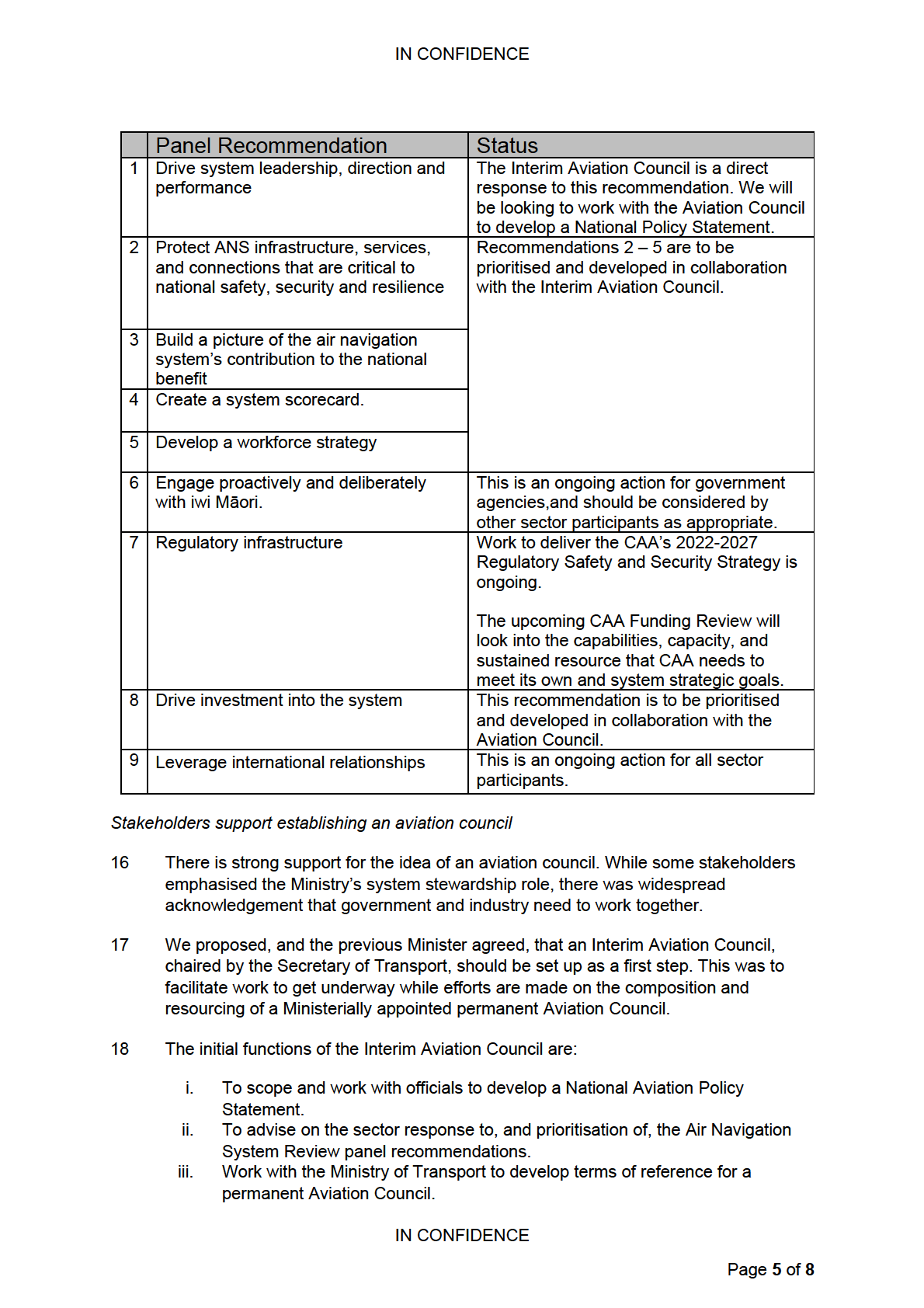
1982
ACT
UNDER
INFORMATION
RELEASED
OFFICIAL
THE
IN CONFIDENCE
iv.
Enable government and industry to voice their opinions and provide advice
and recommendations on how to address challenges facing the sector and
how best to embrace opportunities.
19
We have sent invitations to members of the Aviation Council1, and the first meeting
will be held on 15 March 2024.
1982
ACT
UNDER
INFORMATION
RELEASED
OFFICIAL
THE
1 The members of the Interim Aviation Council are Ministry of Transport (chair), Civil Aviation
Authority, Ministry of Business, Innovation and Employment, New Zealand Defence Force, Air New
Zealand, Airways New Zealand, Aviation New Zealand, Board of Airline Representatives in New
Zealand, NZ Airports, Auckland Airport, New Zealand Airline Pilots Association, a representative who
can bring a te ao Māori perspective, and a representative of emerging technologies.
IN CONFIDENCE
Page
6 of
8
IN CONFIDENCE
Annex 1
Air Navigation System Review – Summary of Recommendations
Recommendation 1
Drive system leadership, direction, and performance through:
•
a ministerially appointed
interim and permanent Aviation Council with whole-
of-system oversight responsibilities;
•
a new and long-range
National Aviation Policy Statement (NAPS); and
•
a Flight Plan for Aotearoa New Zealand: a medium-term aviation and air
navigation direction.
1982
Recommendation 2
Protect the ANS infrastructure, services, and connections that are critical to national safety,
ACT
security and resilience through:
•
defining the minimum operating network, service provision and
performance standards for national safety, security, and essential service
UNDER
connections; and
•
decoupling provision of minimum infrastructure and service levels from
full dependence on user-generated revenue.
Recommendation 3
Build a picture of the
air navigation system’s contribution to the national benefit by
INFORMATION
articulating and measuring the system’s current and potential contribution, including social,
environmental, economic, and cultural outcomes.
RELEASED
Recommendation 4
Create accountabilities for system-wide performance and benefit delivery using a
system
scorecard.
OFFICIAL
Recommendation 5
Develop a workforce strategy, in support of the Flight Plan, to
map and close the gap
between current and future workforce diversity, culture, capacity and capability.
THE
Recommendation 6
Engage proactively and deliberately with iwi Māori to explore and give effect to rights,
interests, and opportunities in the air navigation system.
IN CONFIDENCE
Page
7 of
8
IN CONFIDENCE
Recommendation 7
Strengthen the system’s regulatory infrastructure by:
•
developing a detailed regulatory roadmap based on the CAA delivering its
2022-2027 Regulatory Safety and Security Strategy28 and aligned with the Flight
Plan; and
•
ensuring the regulator has the capabilities, capacity, and sustained
resource to meet its own and system strategic goals.
Recommendation 8
Drive investment into the system through:
•
1982
retaining
user pays plus as the base funding model;
•
additional and targeted Crown investment in critical infrastructure, major
capital projects, and research and development: user pays plus; and
ACT
•
opening options for
alternative sources of capital.
Recommendation 9
UNDER
Leverage our relationships to influence the international agenda and further Aotearoa
New Zealand’s sovereign interest.
INFORMATION
RELEASED
OFFICIAL
THE
IN CONFIDENCE
Page
8 of
8


Document 8
28 February 2024
OC231136
Hon Simeon Brown
Minister of Transport
AVIATION NEW ZEALAND PARLIAMENTARY FUNCTION – MARCH
2024
1982
Snapshot
You are at ending the Aviation New Zealand Parliamentary function. The event is an
opportunity for Aviation New Zealand members to meet with Ministers, officials, and other
ACT
aviation stakeholders.
You have agreed to provide a short speech at the function highlighting key issues and/or
pieces of work on aviation. Following your speech there wil be a Q&A session and light
refreshments.
UNDER
Time and date
5:30pm, Tuesday 5 March 2024
Venue
Grand Hall, Parliament Building, Wellington
Attendees
Attendees include aviation stakeholders, Government Ministers and
officials from the public sector and Crown entities.
INFORMATION
Biographies for Ashok Poduval, President and Simon Wallace, Chief
Executive of Aviation NZ are attached (Annex 1).
RELEASED
Run sheet
Wil be provided nearer to time.
Media
Media have been invited.
Speaking notes
Speech notes are at ached (Annex 2).
OFFICIAL
Bronwyn Turley
Hon Simeon Brown
Deputy Chief Executive - Regulatory
Minister of Transport
THE
.28 / 02 / 2024
..... / ...... / ......
Minister’s office to complete:
Approved
Declined
Seen by Minister
Not seen by Minister
IN CONFIDENCE
Page
1 of
11

1982
ACT
UNDER
INFORMATION
RELEASED
OFFICIAL
THE
considered a ‘hard to abate’ sector, thus there is stil an urgent need to undertake
work early to decarbonise the aviation sector.
8
To this end, Sustainable Aviation Aotearoa (SAA) was established in 2022. The SAA
Leadership Group is made up of executive level representatives to provide
governance and strategic direction, and influence actions within their own
organisations.
9
Simon Wallace has writ en to the Ministry asking to join the SAA Leadership Group.
Ministry officials are considering opportunities to improve the structure of SAA, and
we will respond to Mr Wallace once next steps have been determined. If this is raised,
you can reassure Mr Wallace that Aviation New Zealand wil be included in future
SAA business.
Air Navigation System Review
1982
10
The previous government commissioned an independent panel to undertake a high
level, first principles review of the air navigation system. The Panel delivered its final
report in May 2023.
ACT
11
The Panel identified a lack of system leadership and recommended, among other
things, that an Aviation Council be established.
12
An Interim Council has been set up, chaired by the Secretary of Transport. It will
UNDER
assist with developing a National Policy Statement and develop terms of reference for
a permanent council.
13
Aviation NZ participated as part of the reference group set up to assist the Panel.
Mr Wallace has also been invited to be a member of the Interim Council.
Pilot Training
INFORMATION
14
Aviation NZ has long been vocal about the need to reduce barriers to pilot training for
New Zealanders, primarily around the student loan funding cap. It is concerned that
RELEASED
tertiary borrowing restrictions have resulted in a critical decline in the supply of
commercial pilots in New Zealand and made aviation training less accessible and less
affordable to certain demographic groups.
15
During the COVID-19 pandemic its primary focus was on the closure of New
Zealand’s borders, and the inability of pilot training schools to enrol new overseas
OFFICIAL
students. The closure of the border led to L3Harris Airline Academy, one of the
biggest pilot training schools in New Zealand, closing and consolidating its operations
in Europe.
THE
16
With borders now open most flight schools are back in operation and taking on
international students.
17
With the end to the pandemic, it has become evident that the global pilot shortage is
more acute than previously. Aviation NZ may resume advocating for the removal of
the funding cap, which is the responsibility of the Minister of Tertiary Education.
18
The annual student loan cap of $35,000 was put in place to limit the size of loans to
aviation students.
IN CONFIDENCE
Page
3 of
11
19
There are no plans by the Minister of Tertiary Education to alter the student loan
borrowing cap at the present time for the following reasons:
19.1 Aviation students and graduates stil tend to have very large student loans that
they are slow to repay. The longer it takes borrowers to repay student loans,
the more costly that lending is for the Government.
19.2 The slow repayment of student loans is a reflection of the lack of employment
opportunities available to aviation graduates, low starting salaries, and their
long route to the possibility of a high paying job.
20
If this issue is brought up, we suggest you ask for any new information from the
aviation sector that would support a better understanding of any demand and supply
issues around commercial pilots in New Zealand.
Air Service Agreements
1982
21
A significant number of Aviation NZ members are tourism operators. Air services
agreements (ASAs) facilitate international arrivals and enabling New Zealanders to
journey overseas, promoting mobility and economic growth.
ACT
22
Several initiatives are currently in progress to modernise our Air Service Agreements,
strengthening New Zealand's ties to the rest of the world.
UNDER
23
A noteworthy advancement which may benefit Aviation NZ members is the conclusion
of an agreement with the Association of Southeast Asian Nations (ASEAN). With a
population of nearly 654 mil ion, ASEAN holds considerable importance as a partner
for New Zealand. Trade ties with ASEAN are growing, and it is an important source of
foreign students, tourists, and migrants for New Zealand. Approximately 80,000
individuals of Southeast Asian descent live in New Zealand.
Drones and uncrewed aircraft
INFORMATION
24
Uncrewed Arial Vehicle New Zealand (UAVNZ) is a division of Aviation New Zealand.
RELEASED
It works to advocate for, and professionalise, the uncrewed aerospace sector in New
Zealand. UAVNZ includes operators, manufacturers, researchers, Airshare (part of
Airways New Zealand), Callaghan Innovation, and others focused on UAV industry
growth.
25
Uncrewed aircraft (drones) can offer operational and productivity gains across a
OFFICIAL
number of industries, especially in primary sectors such as forestry, agriculture, and
dairy, which are key industries that the members of Aviation NZ are involved in.
26
In 2021, the Ministry, with the assistance of the Civil Aviation Authority, undertook
THE
public consultation on the introduction of a package of regulatory measures (including
registration and basic pilot qualification), to progress drone integration and solve
ongoing problems related to drone use. The Ministry continues to work on these
regulatory issues, which are also important enablers for the advanced aviation and
space sectors.
27
Ministry officials have recently met with UAVNZ leadership. UAVNZ is advocating for
a licensing regime for drone operators as a way to further professionalise the sector.
IN CONFIDENCE
Page
4 of
11
UAVNZ also views licensing as a way to increase public acceptance of drones and
improve the safety and wellbeing operators.
28
The main difference between licensing and basic pilot qualification is that the former
involves the issuing of an aviation document1 by the CAA, whilst the latter does not.
1982
ACT
UNDER
INFORMATION
RELEASED
OFFICIAL
THE
1 An aviation document is any licence, permit, certificate, or other document issued under the Civil Aviation Act
1990 to, or about, any person, aircraft, aerodrome, aeronautical product, or aviation-related service.
IN CONFIDENCE
Page
5 of
11

 Annex 1: Key People
Ashok Poduval, President of Aviation New Zealand.
Annex 1: Key People
Ashok Poduval, President of Aviation New Zealand.
Ashok is also the Chief Executive of Massey University School of
Aviation based in Palmerston North. Ashok has over 12,000 hours
of airline jet flying experience and has held senior management
roles at Gulf Air and as the Director of Flight Operations and Safety
Services at IATA.
Simon Wallace, Chief Executive of Aviation New Zealand
1982
Simon joined Aviation New Zealand as Chief Executive in August
2023, and his responsibilities include leading strategic development
and implementation in accordance with the directives of the Aviation
ACT
New Zealand Council.
Previously, Simon was Chief Executive Of icer at the New Zealand
Aged Care Association (NZACA). He has also held leadership
positions at Tourism Industry Association of N
UNDER ew Zealand (now
Tourism Industry Aotearoa).
INFORMATION
RELEASED
OFFICIAL
THE
IN CONFIDENCE
Page
6 of
11
Annex 2: Speech - Aviation New Zealand Parliamentary Function – March 2024
Simeon Brown
10 – 15-minute speech
Structure of this speech
• Introduction
• The role of aviation in an integrated transport strategy
• Policy and regulation encouraging the growth of aviation
• Civil Aviation Act 2023 Implementation
• Air Service Agreements
• Drones and the usage of airspace
1982
• Air Navigation Systems Review
• Sustainable Aviation Aotearoa and Decarbonisation of Aviation
• Conclusion/wrap up
ACT
Introduction
•
Kia ora koutou, and thank you for the warm welcome.
•
I would like to thank Simon for the introduction and for the opportunity to speak here
UNDER
this evening.
•
Before I begin, I would like to acknowledge the President of Aviation New Zealand,
Ashok Poduval and the Chief Executive of Aviation New Zealand, Simon Wallace.
•
I would also like to thank the members of Aviation NZ for all the great work you do. We
have a fantastic aviation industry and this wouldn’t be possible without all of your hard
work and support.
INFORMATION
•
Evenings such as this one are a great opportunity to meet with you and talk about the
Government’s priorities.
RELEASED
•
It is also important for me to further understand the commercial general aviation
sector’s priorities and how we can work together to achieve greater results and
success.
The role of aviation in an integrated transport strategy
•
This is an exciting time to be in the aviation industry. Aviation is critical to our economy
OFFICIAL
and a vital part of our transport sector. It drives connectivity and economic growth and
contributes in no small way to our GDP.
•
Your industry is vital to New Zealand’s prosperity and links with the rest of the world.
THE
•
The injection of tourism, talent and trade you enable benefits our cities, towns and
regions.
Policy and regulation encouraging the growth of aviation
•
We are committed to working collaboratively with the aviation industry to help address
issues and create opportunities for the industry to flourish domestically and
internationally.
IN CONFIDENCE
Page
7 of
11
•
One of the ways of doing this is to remove barriers to progress in policy and regulations
and allow the use of new technologies, while maintaining safety and managing
transport emissions.
•
We also want government aviation agencies to be as efficient as possible and provide
value for money.
Civil Aviation Act 2023 Implementation
•
Work is continuing on implementing the new Civil Aviation Act 2023, which was
enacted in April last year.
•
I am grateful for your support for the new Act, including the submissions Aviation
New Zealand and many others made to the Transport and Infrastructure Commit ee
back in 2021 and 2022.
•
The Act is necessary to keep pace with a rapidly changing aviation environment, and
our primary goal remains ensuring that New Zealand maintains a safe and secure civil
1982
aviation system.
•
When it comes into force on 5 April 2025, the Act wil introduce some welcome
changes to help the sector better keep pace with the operating environment, while also
ACT
recognising that our regulatory underpinnings are fundamentally sound.
•
The Ministry of Transport and the Civil Aviation Authority are working closely together
to implement this work.
•
They wil be involving sector participants throughout the coming y
UNDER ear before the Act
comes into force on 5 April 2025 – I encourage you and your members to take part in
this process.
Air Service Agreements
•
Tourism has and wil continue to play an important role in the New Zealand economy.
•
Air services agreements play a crucial role in supporting tourism by enabling
international arrivals and allowing New Zealanders to travel abroad, fostering mobility
INFORMATION
and economic development.
RELEASED
•
A significant development in our air services arrangements is the conclusion of an
agreement with the Association of Southeast Asian Nations – known as ASEAN.
Home to nearly 654 mil ion people, ASEAN is a very important partner for New
Zealand.
•
This agreement wil further strengthen our relationship with the region.
OFFICIAL
•
I know that Aviation NZ members are active in this region, especially in Viet Nam. This
agreement has the potential of leveraging on the thriving trade relationship New
Zealand has with ASEAN being one of New Zealand’s most significant sources of
foreign students, tourists and migrants.
THE
Drones and the usage of airspace
•
There is a lot of interest in your sector around drones and the impact they may have on
your operations.
•
Our regulatory settings wil need to keep up with technology so we can maximise the
benefits of advanced drones used for commercial purposes, while managing the risks
associated with smaller drones used primarily for recreational purposes.
IN CONFIDENCE
Page
8 of
11
•
Drones have the potential to change how we move people and freight. They are
already transforming how we undertake certain tasks across a wide range of sectors,
and wil continue to do so in ways we can’t even imagine today.
•
The government is committed to progressing work on regulatory settings to support the
sector, including issues related to drone integration
•
This work is the beginning of an ongoing and open dialogue with the aviation sector
about the future of aviation in New Zealand, and the role you can play to help us
achieve integration.
Air Navigation Systems Review
•
The aviation industry, technology and our regulatory and security environments
continue to evolve.
•
The Air Navigation System Review, undertaken last year, identified a lack of system
leadership and recommended among other things that an Aviation Council be 1982
established.
•
An Interim Aviation Council has been established to assist with developing a National
Policy Statement and terms of reference for a permanent council. ACT
•
Simon will sit on the Interim Council and I’m sure wil contribute the views of you all to
the work undertaken by the Council.
•
The Council and the National Aviation Policy Statement are foundational actions and
wil provide an agreed basis on which the Government and privat
UNDER e sector can work
together to move the sector forward.
Sustainable Aviation Aotearoa and Decarbonisation of Aviation
• We are part of a global system, and that’s why ensuring our aviation sector is
sustainable is critical for its long-term future. I acknowledge that supporting aviation
decarbonisation is a priority for most of you in the room.
• To fully understand what decarbonisation of the sector wil entail, Sustainable
INFORMATION
Aviation Aotearoa has been set up. This is the Government’s public-private
partnership with the aviation sector. It wil w
RELEASED ork to provide strategic direction for low-
and-zero-emission aviation, and support the sector to accelerate the decarbonisation
of aviation.
Conclusion/wrap up
• Aviation is continuously evolving and the Government wil continue to work in
partnership with the sector to ensure we are appropriately prepared for the future.
OFFICIAL
• We are committed to helping address issues and create opportunities for the aviation
industry to flourish domestically and internationally.
• Events like this one are a great opportunity for us all to acknowledge and celebrate
THE
the work you have all done to contribute to this thriving industry.
• I wish you well for the rest of your evening.
IN CONFIDENCE
Page
9 of
11
FAQS
FAQ – Civil Aviation Act 2023 implementation
Wil al the new policy proposals reflected in the Act be implemented by 5 April 2025?
•
Implementation work is targeted at parts of the system that need to change now to
enable the civil aviation system to safely continue without unnecessary disruption to
business as usual. Anything not included in the implementation work can be brought in
as time and resources allow.
When wil the new drug and alcohol management system take effect?
•
There wil be a two-year transition period for drug and alcohol provisions, starting on 5
April 2025. During the transition time drug and alcohol management plans wil be
approved by CAA, so that the new regime is in place by 5 April 2027.
Which CAA decisions can be reviewed by the new independent review function?
•
The scope of reviewable decisions (i.e. which decisions can be reviewed) wil be set
1982
out in regulation. Sector participants wil be consulted on which decisions wil be
reviewable as part of the regulation-making process, around the middle of this year.
FAQ – Sustainable Aotearoa and Decarbonisation of Aviation
ACT
What is Sustainable Aviation Aotearoa (SAA)?
• Sustainable Aviation Aotearoa (SAA) was established in 2022, as a public-private
partnership (akin the to the UK’s Jet Zero Council), to provide advice and
coordination on the decarbonisation of New Zealand’s aviation sector.
UNDER
How were the SAA Leadership Group membership chosen?
• Of icials are reviewing SAA arrangements to ensure its membership appropriately
reflects the sector. I look forward to Aviation New Zealand’s future involvement with
SAA.
How do you plan to support the decarbonisation of aviation in New Zealand?
• In addition to facilitating SAA, the Government wil support the phase down of fossil
fuels, by enabling the development of sustainable aviation fuels and technology to
INFORMATION
help decarbonise the sector.
RELEASED
Is the Government planning to introduce a Sustainable Aviation Fuel (SAF) mandate?
•
I am currently reviewing advice I have received from MBIE officials on the proposal for
a Sustainable Aviation Fuel (SAF) mandate, to determine the most appropriate next
steps.
FAQ – Drones
OFFICIAL
What is the Government doing to enable Drone integration?
•
We are looking at a regulatory work to enable drone integration in a safe and secure
way.
THE
•
To accelerate the process MBIE is conducting the Airspace Integration Trials
programme, which is focused on the safe testing, development, and market validation
of drones.
What is being done to make sure drones are operating in safe ways?
•
The government is looking at ways to address the aviation safety and security
challenges that drones present. Tools to achieve this could include basic pilot
accreditation; drone registration; remote identification; and geo-awareness.
IN CONFIDENCE
Page
10 of
11
FAQs – Air Navigation System Review
What did the Panel recommend?
•
The panel made nine recommendations to strengthen the system. These include
improved system leadership, identifying critical system components, funding,
understand the value of the aviation sector, workforce (including regulatory capability),
engagement with Māori and leveraging international relationships.
What wil the Interim Council do?
•
The Interim Council’s functions include:
o Working with officials on a National Aviation Policy Statement
o Helping to prioritise the recommendations from the Air Navigation System Review;
and
o Enabling an exchange of views on how to address challenges and embrace the
opportunities facing the sector.
1982
ACT
UNDER
INFORMATION
RELEASED
OFFICIAL
THE
IN CONFIDENCE
Page
11 of
11
Document Outline

































